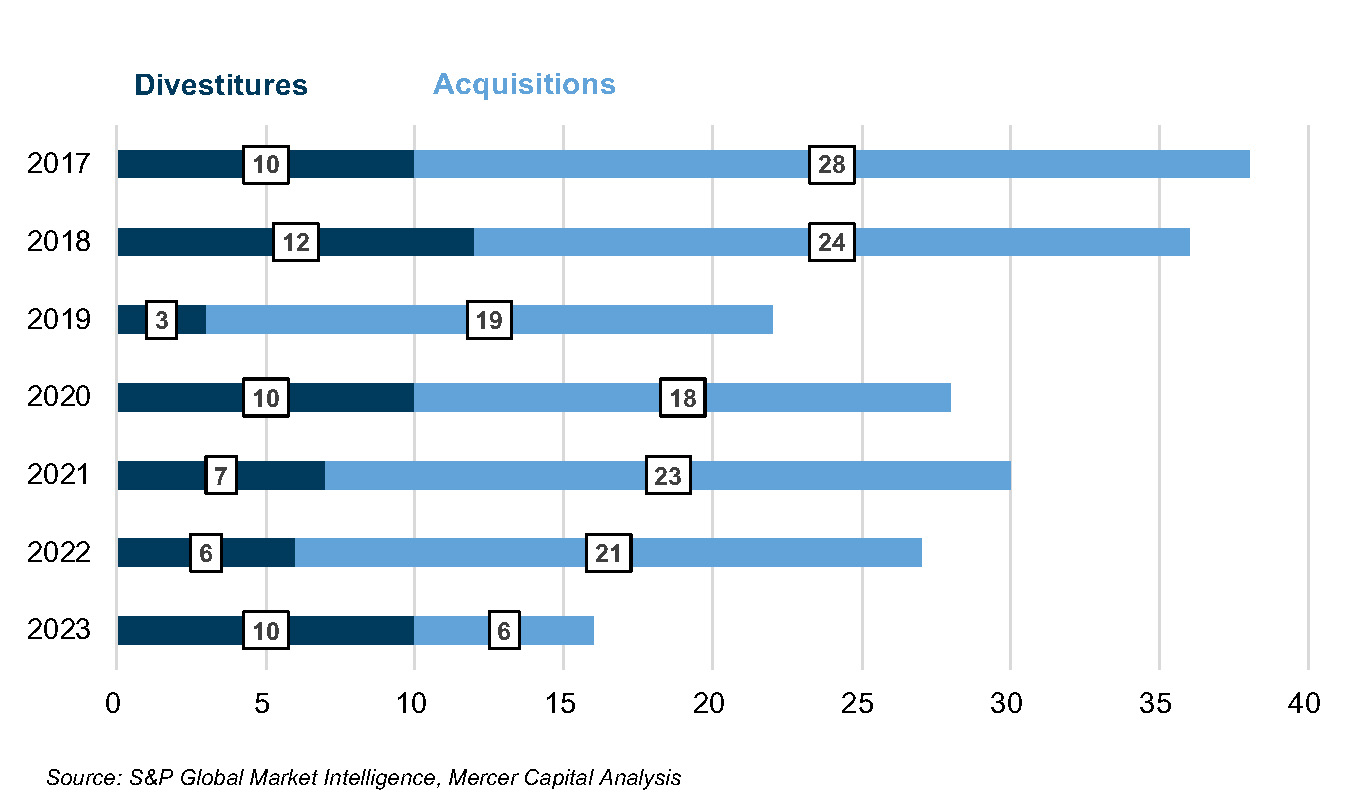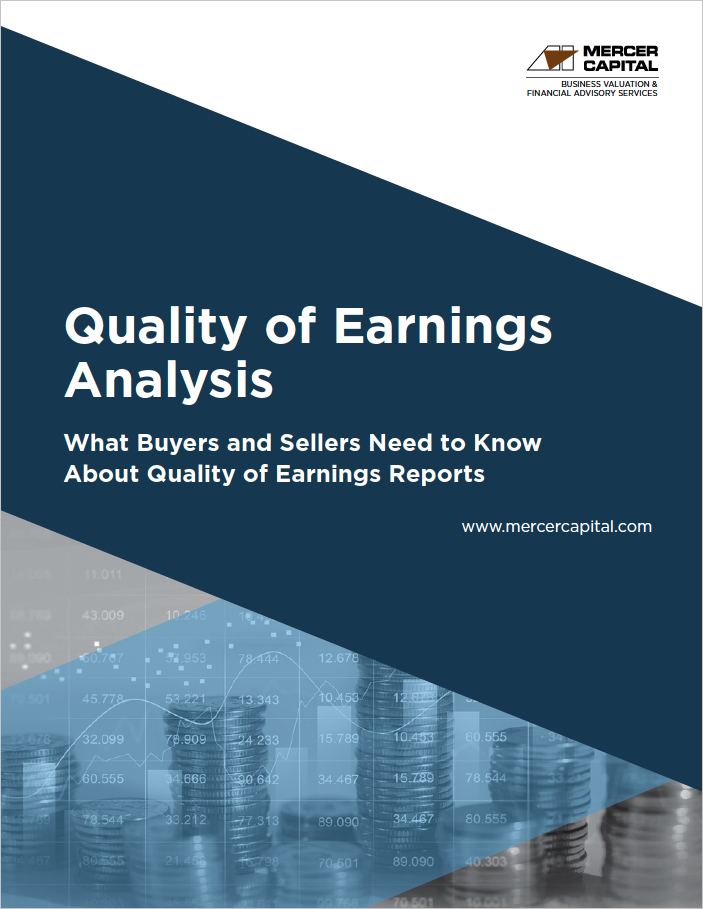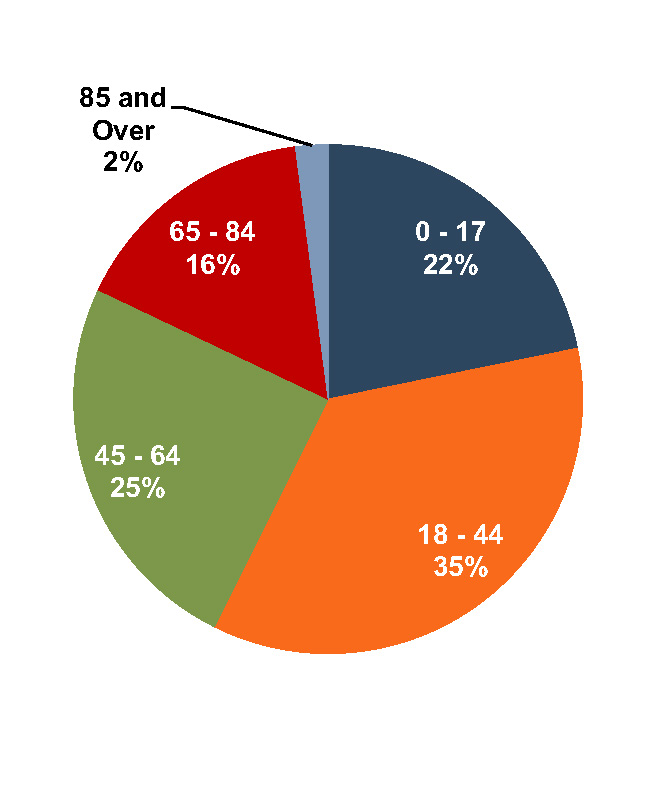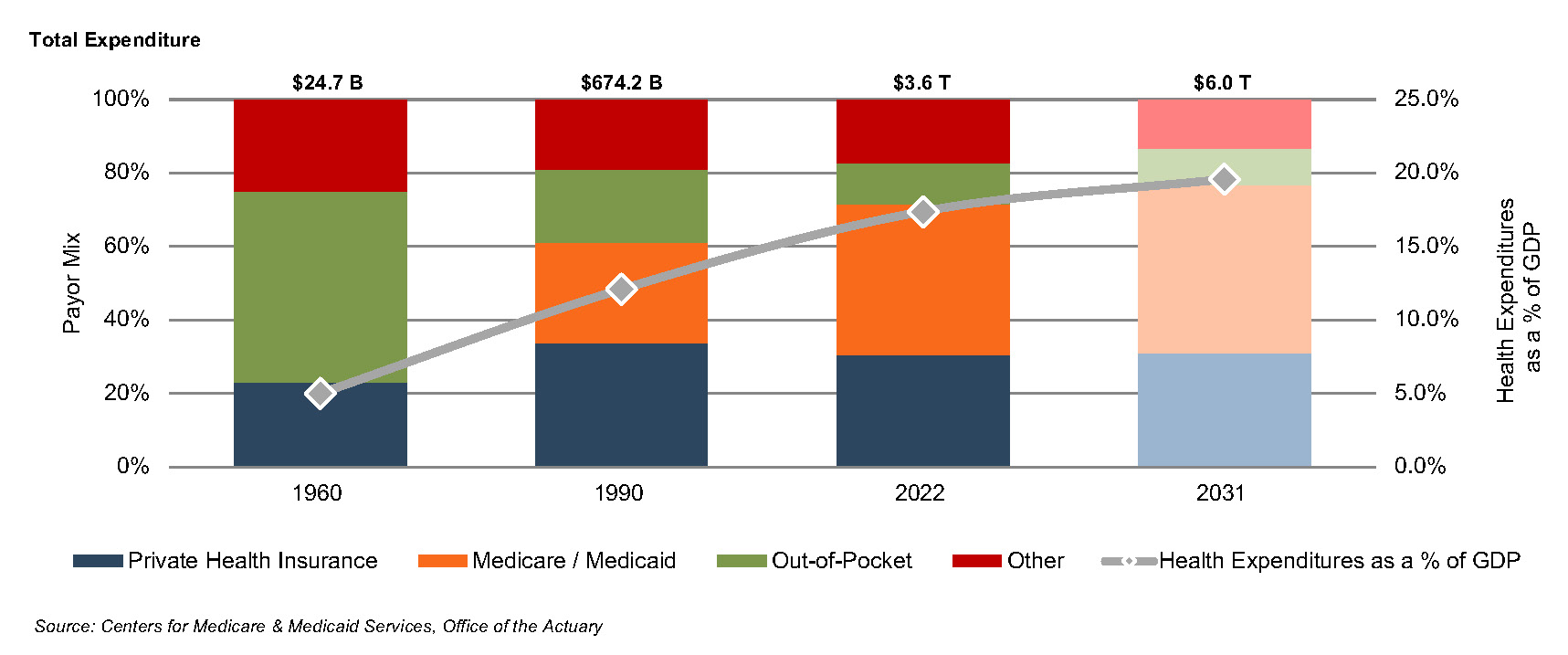Buy-Sell Agreements: Valuation Handbook for Attorneys
Published by the American Bar Association, Buy-Sell Agreements: Valuation Handbook for Attorneys is a one-of-a-kind resource for attorneys representing business owners.
Well-prepared buy-sell agreements establish a valuation process to set the price at which a transaction will occur when trigger events happen. Many, if not most, buy-sell agreements in existence today have dated language pertaining to the description of their appraisal processes and the definitions of the price to be set by these processes.
The book, penned by Mercer Capital’s Z. Christopher Mercer, FASA, CFA, ASA, a business appraiser and veteran of many buy-sell agreement disputes, scrutinizes common issues in current agreements and suggests improvements.
The book also provides seven elements that should be clearly defined in every agreement, including:
- Standard of value (like fair market value)
-
Level of value (like financial control)
-
Going concern requirement
-
“As-of” date
-
Qualifications of appraisers
-
Appraisal standards to be followed
-
Consideration of life insurance proceeds
The importance of this last element has been heightened by the U.S. Supreme Court decision in Connelly, which affects buy-sell agreements involving life insurance, as discussed in the book’s appendix.
Importantly, the book provides example language for consideration by attorneys when drafting buy-sell agreements that contain language important to the valuation process.
Attorneys will find that Buy-Sell Agreements: Valuation Handbook for Attorneys will be an invaluable resource for reviewing existing agreements or drafting new ones.
** NOTE ** : Clicking the “Add to Cart” button takes you to the ABA’s website where you can order.
2024 Core Deposit Intangibles Update
Since Mercer Capital’s most recently published article on core deposit trends in September 2023, deal activity in the banking industry has continued to be rather anemic, but could be showing signs of recovery. Although deal activity has been slow, we have seen a marginal uptick in core deposit intangible values relative to this time last year.
On July 26, 2023, the Federal Reserve increased the target federal funds rate by 25 basis points, capping off a collective increase of 525 basis points since March 2022. Although cuts to the fed funds target rate were anticipated several times over the past year, no changes materialized until the Federal Reserve’s September 2024 meeting. While many factors are pertinent to analyzing a deposit base, a significant driver of value is market interest rates. All else equal, lower market rates lead to lower core deposit values. As shown below, the yield curve for U.S. Treasuries has shifted downward relative to last year at this time, and the market expects further downward movement in short-term rates in the near term.
Figure 1: U.S. Treasury Yield Curve
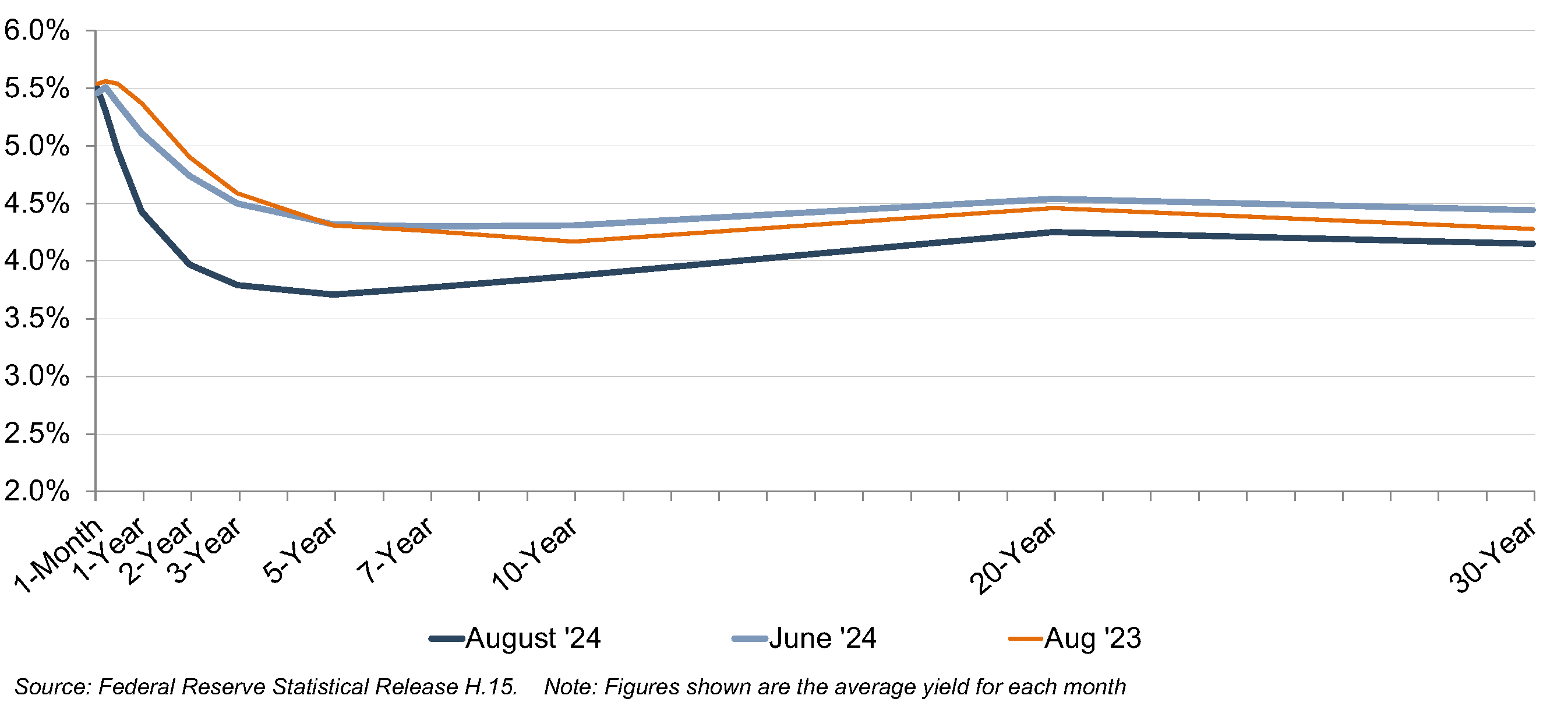
Trends in CDI Values
Using data compiled by S&P Capital IQ Pro, we analyzed trends in core deposit intangible (CDI) assets recorded in whole bank acquisitions completed from 2000 through mid-September 2024. CDI values represent the value of the depository customer relationships obtained in a bank acquisition. CDI values are driven by many factors, including the “stickiness” of a customer base, the types of deposit accounts assumed, the level of noninterest income generated, and the cost of the acquired deposit base compared to alternative sources of funding. For our analysis of industry trends in CDI values, we relied on S&P Capital IQ Pro’s definition of core deposits.1 In analyzing core deposit intangible assets for individual acquisitions, however, a more detailed analysis of the deposit base would consider the relative stability of various account types. In general, CDI assets derive most of their value from lower-cost demand deposit accounts, while often significantly less (if not zero) value is ascribed to more rate-sensitive time deposits and public funds. Non-retail funding sources such as listing service or brokered deposits are excluded from core deposits when determining the value of a CDI.
Figure 2, on the next page, summarizes the trend in CDI values since the start of the 2008 recession, compared with rates on 5-year FHLB advances. Over the post-recession period, CDI values have largely followed the general trend in interest rates—as alternative funding became more costly in 2017 and 2018, CDI values generally ticked up as well, relative to post-recession average levels. Throughout 2019, CDI values exhibited a declining trend in light of yield curve inversion and Fed cuts to the target federal funds rate during the back half of 2019. This trend accelerated in March 2020 when rates were effectively cut to zero.
Figure 2: CDI as % of Acquired Core Deposits
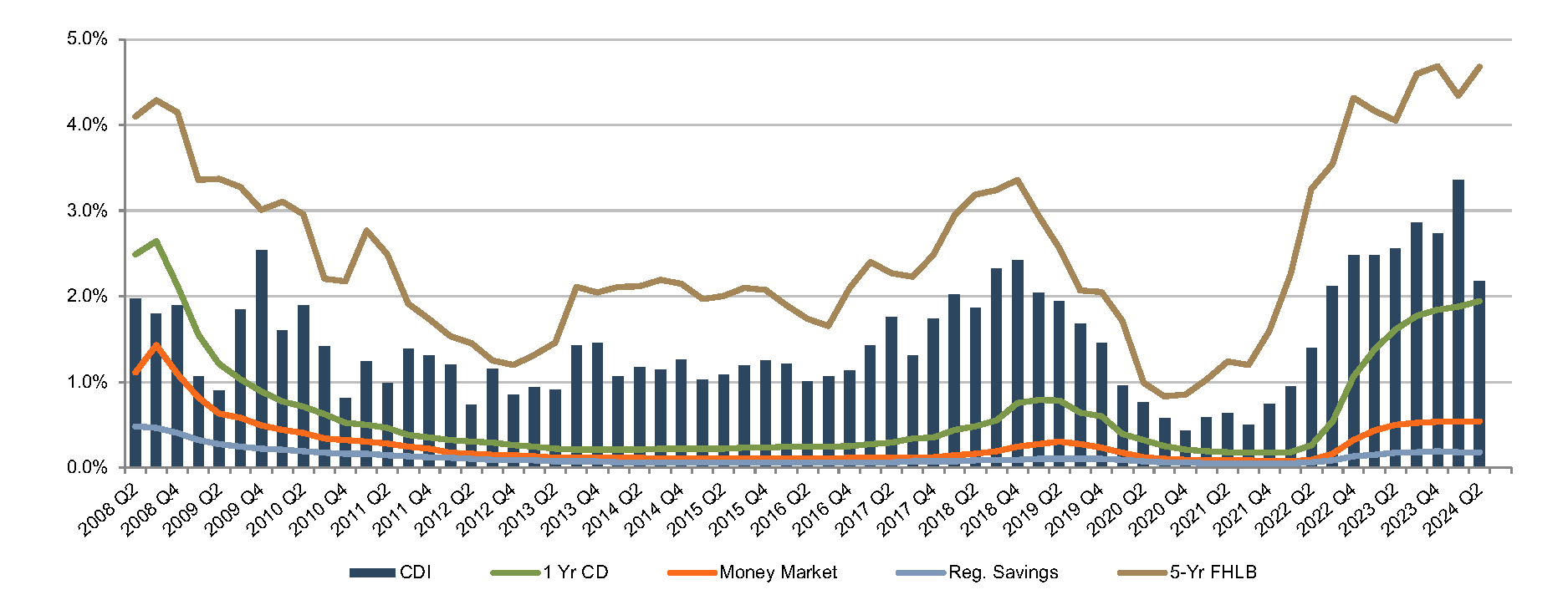
Source: S&P Capital IQ Pro
Click here to expand the image above
CDI values have increased meaningfully in the past few years (averaging 2.74% through mid-September 2024). This compares to 2.58% all of 2023, 1.61% all of 2022 and 0.63% for all of 2021. Recent values are above the post-recession average of 1.47%, and on par with longer-term historical levels which averaged closer to 2.5% to 3.0% in the early 2000s.
As shown in Figure 2, reported CDI values have followed the general trend of the increase in FHLB rates. However, the averages should be taken with a grain of salt. The chart is provided to illustrate the general directional trend in value as opposed to being predictive of specific indications of CDI value due the following factors:
- Last week’s Federal Reserve rate cuts are not reflected in the data above. While the impact on CDI values of one 50 basis point reduction in the fed funds target rate may not be highly material—given that the forward rate curve has anticipated falling short-term interest rates for some time—continued reductions in the fed funds target rate or downward shifts in the yield curve may result in a larger decline in CDI values.
- General market averages do not reflect the individual characteristics of a particular subject’s deposit base.
- Some of the values presented above reflect the estimated core deposit intangible value at deal announcement, rather than the final core deposit intangible value as determined post-closing.
Twenty-three deals were announced in July, August, and the first half of September, and ten of those deals provided either investor presentations or earnings calls containing CDI estimates. Excluding one outlier with a 1.06% estimated CDI value, these CDI estimates ranged from 2.7% to 4.1%. However, the CDI premiums cited in investor presentations can be somewhat difficult to compare, as acquirers may use different definitions of core deposits when calculating the CDI premiums reported to investors. For example, some acquirers may include CDs in the calculation, while other buyers may exclude CDs or include only certain types of CDs.
Generally, we expect CDI values to fall in concert with falling market interest rates. How fast they decline could depend several factors:
- Cost of Funds. Although many believe deposit rates have peaked, a possibility remains that deposit rates will not be as flexible on the way down. For example, notifications of lower rates may trigger some depositors, now accustomed to higher rates, to seek alternatives. Banks may need to weigh their desire to reduce deposit rates against the need to preserve deposit balances. As shown on Figure 3, in falling rate environments, the median cost of funds has tended to decrease at a slower rate than the fed funds target rate. However, interest rate beta is in part determined by the size of the financial institution, as evidenced by Figure 4.
- Deposit Levels. In 2022, total industry deposits fell 1.1%, the largest annual decline on record.2 Last year at this time, less than half of respondents expected deposits to increase at their organization over the next 12 months. However, deposits have been relatively flat since this time last year. In the same survey for the second quarter of 2024, three out of five bankers expect deposits to grow over the next twelve months.3 All else equal, lower deposit runoff assumptions lead to higher indications of CDI value.
Figure 3: Median Cost of Funds as Compared to Target Fed Funds Rate
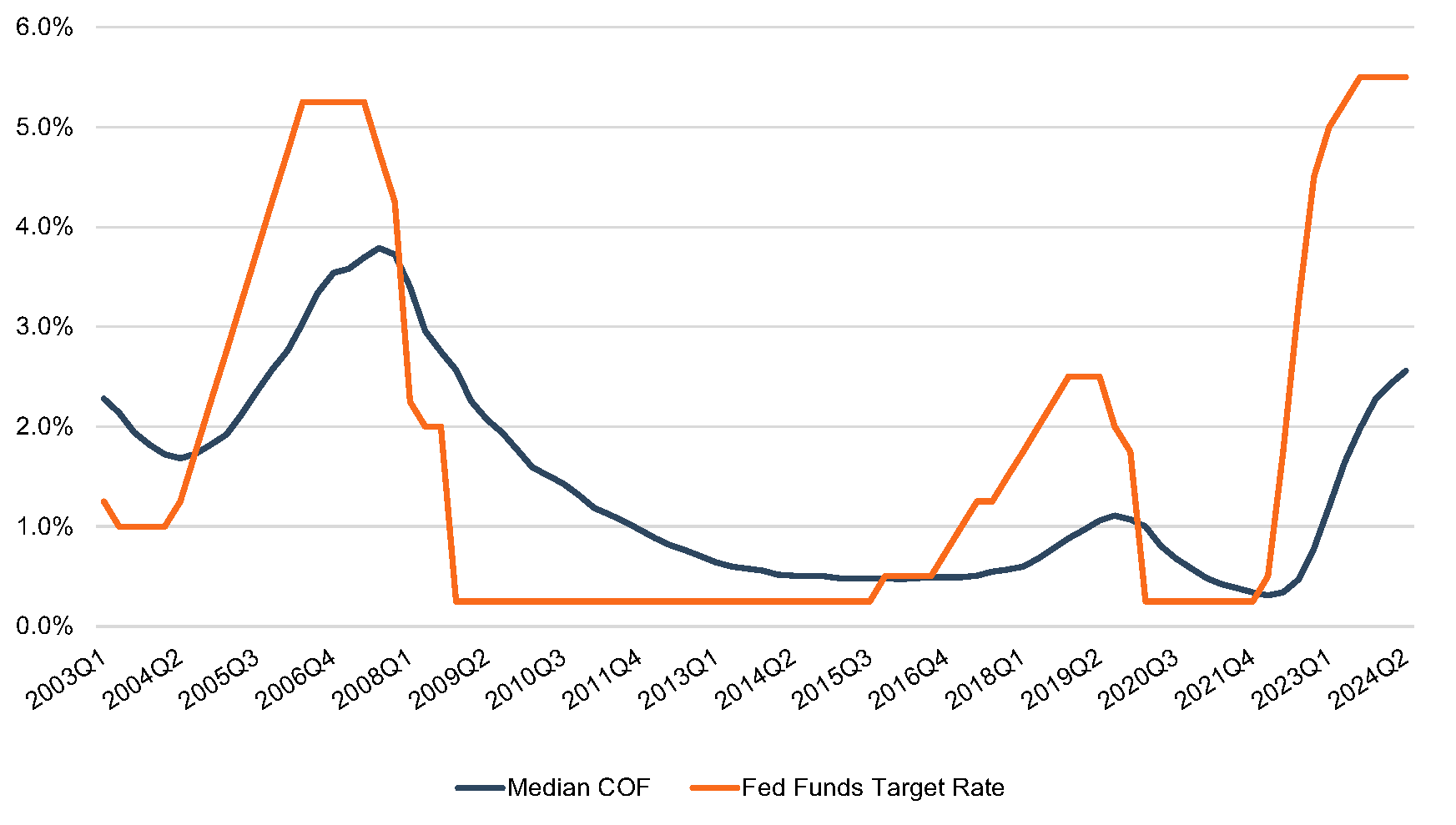
Source: S&P Capital IQ Pro
Figure 4: Cost of Funds by Asset Size – 2Q22 to 2Q24
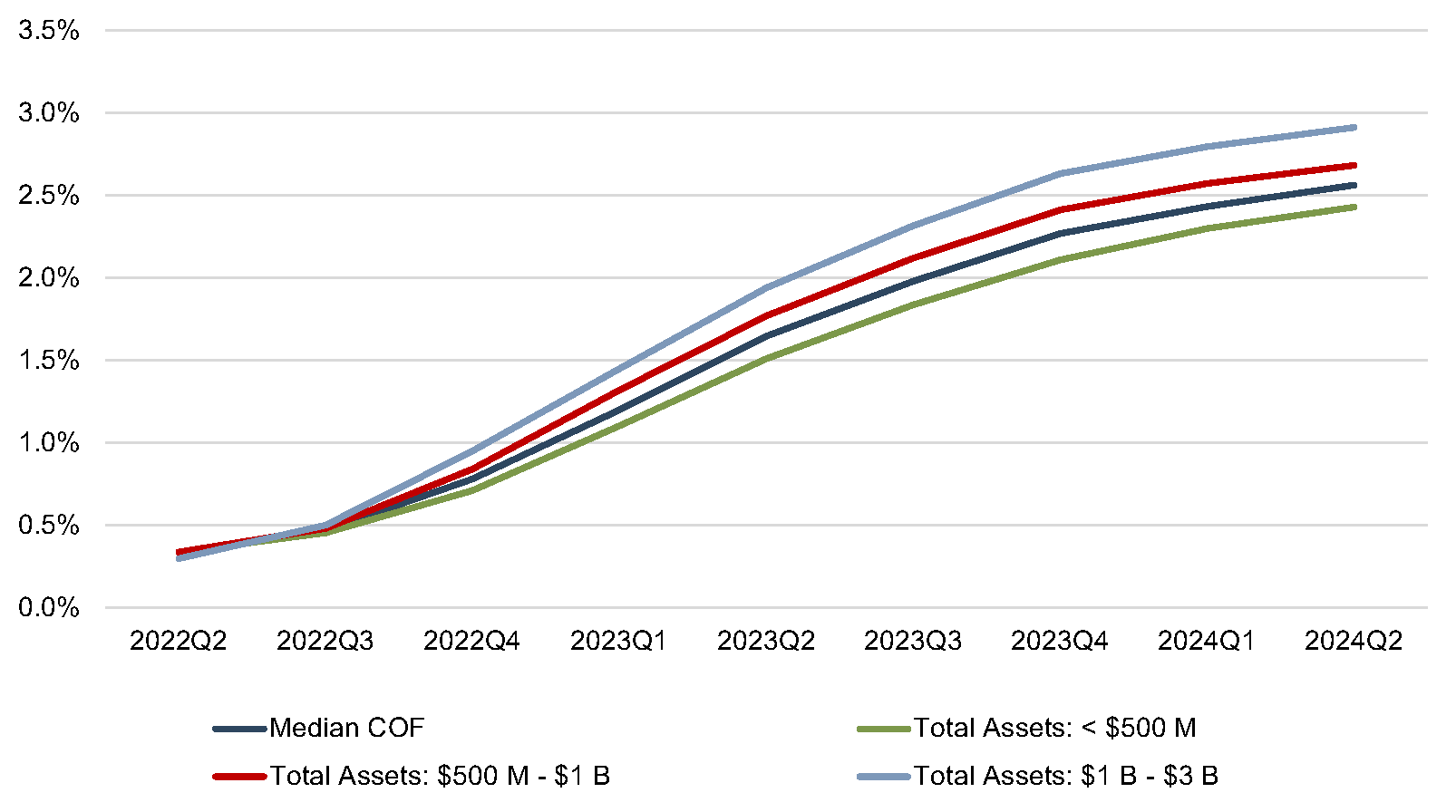 Source: S&P Capital IQ Pro
Source: S&P Capital IQ Pro
Figure 5: Total Industry Deposits Per Federal Reserve H.8 Release
 Source: S&P Capital IQ Pro
Source: S&P Capital IQ Pro
- Deposit Mix and Deposit Beta. Over the past decade, nationwide average deposit mix has shifted in favor of noninterest bearing deposits. In 2023 and 2024, this trend began to reverse in a higher interest rate environment. However, the deposit mix shift toward interest bearing deposits might not continue in a falling interest rate environment. As noninterest-bearing deposits have higher CDI values, this could be a mitigating factor for the anticipated decline in CDI values.
- Uncertain Rate Outlook. At present, the upside risks to inflation have diminished. Should recent positive inflation trends reverse, the Federal Reserve is likely to pause interest rate cuts or even increase rates again. Seven of the FOMC participants expect a further 25 basis point cut in 2024, while nine predict 50 basis points of additional cuts. Two predict no additional cuts, and one predicts a total of 75 basis points of cuts.
Figure 6: Deposit Mix Over Time
 Source: S&P Capital IQ Pro
Source: S&P Capital IQ Pro
- Other Factors. More details within the deposit trial balance tend to provide more meaningful indications of depositor value – and this is especially important to consider on the front end of a deal. When possible, we like to see a customer relationship identifier, information on industry concentrations, more granular detail on account types, several years of deposit history, demographic details surrounding customer age and location, and average account balances over time.
Admittedly, this level of detail is not always feasible due to data limitations, but more detail contributes to a more comprehensive “story” of the deposit base. Before you can value the core deposit intangible asset, you need to begin by ascertaining which accounts and balances are “core”. Furthermore, sometimes a particular relationship might be core, but some or most of its balances at a particular point in time might not be.
Trends In Deposit Premiums Relative To CDI Asset Values
Core deposit intangible assets are related to, but not identical to, deposit premiums paid in acquisitions. While CDI assets are an intangible asset recorded in acquisitions to capture the value of the customer relationships the deposits represent, deposit premiums paid are a function of the purchase price of an acquisition. Deposit premiums in whole bank acquisitions are computed based on the excess of the purchase price over the target’s tangible book value, as a percentage of the core deposit base.
While deposit premiums often capture the value to the acquirer of assuming the established funding source of the core deposit base (that is, the value of the deposit franchise), the purchase price also reflects factors unrelated to the deposit base, such as the quality of the acquired loan portfolio, unique synergy opportunities anticipated by the acquirer, etc. As shown in Figure 7, deposit premiums paid in whole bank acquisitions have shown more volatility than CDI values. Deposit premiums were in the range of 6% to 10% from 2015 to 2022, although this remained well below the pre-Great Recession levels when premiums for whole bank acquisitions averaged closer to 20%. Net interest margin pressure—caused by assets originated at low rates during the pandemic and deposits that proved more rate sensitive than expected—resulted in deposit premiums in 2024 falling to levels last seen in the Great Financial Crisis.
Additional factors may influence the purchase price to an extent that the calculated deposit premium doesn’t necessarily bear a strong relationship to the value of the core deposit base to the acquirer. This influence is often less relevant in branch transactions where the deposit base is the primary driver of the transaction and the relationship between the purchase price and the deposit base is more direct. Figure 8 presents deposit premiums paid in whole bank acquisitions as compared to premiums paid in branch transactions.
Deposit premiums paid in branch transactions have generally been less volatile than tangible book value premiums paid in whole bank acquisitions. Only two branch transactions with reported premium data have occurred year-to-date in 2024. For those transactions, the deposit premiums were 7.5% and 4.0%. The lack of branch transactions, though, is indictive of their value. With high short-term funding costs and tight liquidity, few banks have been willing to part with stable, low-cost core deposits.
Figure 7: CDI Recorded vs. Deposit Premium
 Source: S&P Capital IQ Pro
Source: S&P Capital IQ Pro
Figure 8: Average Deposit Premiums Paid
 Source: S&P Capital IQ Pro
Source: S&P Capital IQ Pro
Accounting For CDI Assets
Based on the data for acquisitions for which core deposit intangible detail was reported, a majority of banks selected a ten-year amortization term for the CDI values booked. Less than 10% of transactions for which data was available selected amortization terms longer than ten years. Amortization methods were somewhat more varied, but an accelerated amortization method, including the sum-of-the-years digits method, was selected in approximately two-thirds of these transactions.
For more information about Mercer Capital’s core deposit valuation services, please contact a member of our Depository Institutions team.
Figure 9: Selected Amortization Term (Years)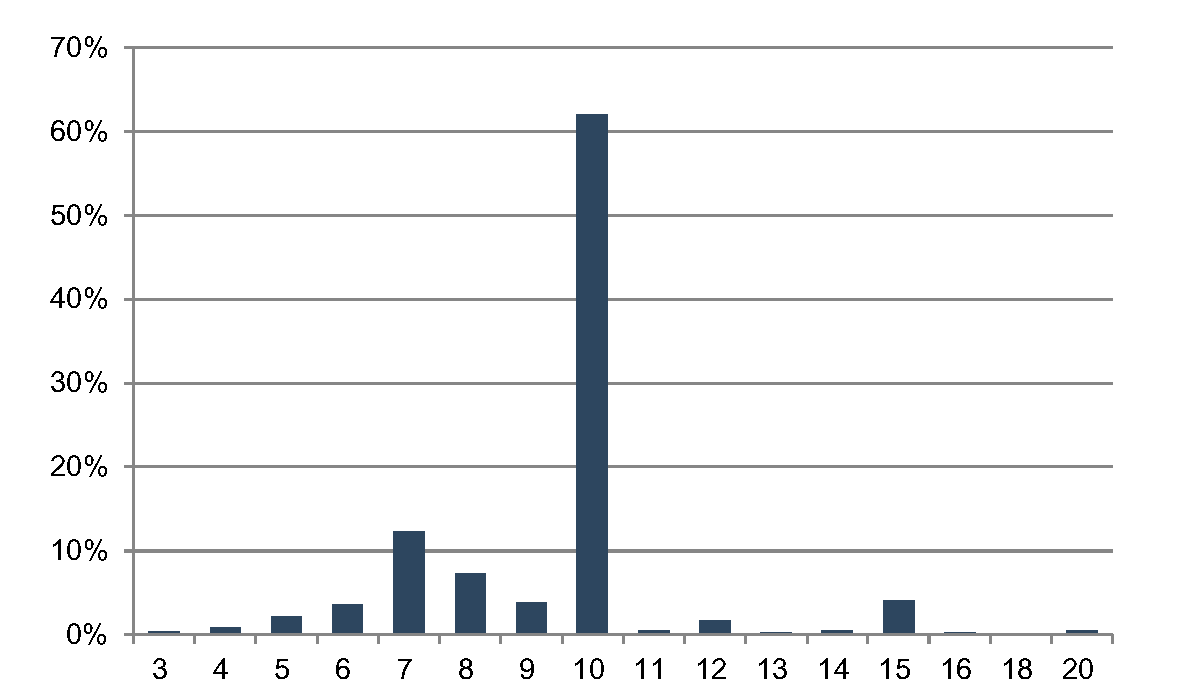
Source: S&P Capital IQ Pro
Figure 10: Selected Amortization Method
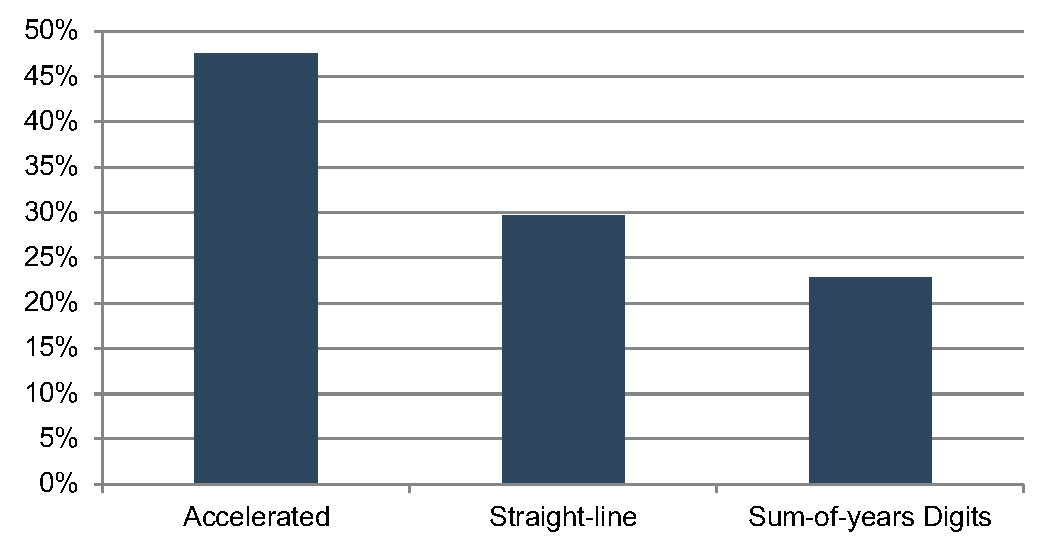 Source: S&P Capital IQ Pro
Source: S&P Capital IQ Pro
1 S&P Capital IQ Pro defines core deposits as, “Deposits in U.S. offices excluding time deposits over $250,000 and brokered deposits of $250,000 or less.”
2 Defined by the Federal Reserve as domestically chartered commercial banks.
3 According to S&P Capital IQ Pro’s US Bank Outlook Survey
Real Estate and the Family Business in Divorce
Travis Harms recently wrote a piece for our Family Business Director Blog about the family business’ investment in real estate. Below, we have adapted his piece for business owner clients going through a divorce.
As the pandemic recedes further into the rearview mirror, long-term business consequences continue to reverberate through the economy. In addition to recalibrating expectations among domestic manufacturers, foreclosures on distressed commercial real estate are accelerating.
For many business owners and their spouses, the marital net worth may be concentrated in the value of the business. Furthermore, the company’s real estate can be a significant portion of this value or may represent additional value. The lingering pandemic-induced weakness in commercial real estate values may encourage families to re-evaluate their real estate strategies, though this varies by asset class, use, and geography among many other considerations. Re-evaluating real estate strategies is particularly necessary for couples seeking to equitably divide assets in a marital estate pursuant to a divorce.
Below we highlight three real estate strategies we often see for those who own and operate a business.
Real estate strategy #1 – Operating business owns real estate needed for operations
This strategy is often the default strategy for enterprising families.
- This approach has the virtue of simplicity. When additional productive assets are needed to take advantage of growth opportunities, the company acquires them, whether those assets consist of machinery & equipment or real estate.
- Owned real estate provides the operating business with leverage capacity. Lenders take comfort in real estate as collateral, so businesses that accumulate operating real estate on their balance sheets will likely have greater borrowing capacity when attractive investment opportunities arise.
- All else equal, an operating business that owns real estate is probably less risky than one that does not. Real estate holdings are likely to have alternative future uses outside the business and carry less risk than intangible assets, goodwill, and other assets that are specific to an operating business.
- Real estate offers the prospect of capital appreciation. Rolling stock, production equipment, and other operating assets depreciate and lose value over the long term. In contrast, investments in operating real estate can provide opportunities for capital appreciation in addition to the value created through operating the business.
Real estate strategy #2 – Operating business leases real estate needed for operations from a third party
Instead of purchasing real estate for operations, some family businesses elect to lease facilities needed for operations from unrelated third parties.
- This strategy preserves the greatest flexibility for the operating business. Beyond the remaining term of the lease agreement, the operating business is not committed to the real estate from which it operates. As strategies and market opportunities evolve, the operating business’s real estate needs are likely to evolve as well.
- Leasing real estate from a third party allows management of the operating business to focus on running the business. Call it “core competency” or what have you: developing & managing real estate well requires a different skill set than running an operating business. Leasing the real estate needed for operations rather than owning allows the management team to focus on what they do best.
- Leasing can boost return on invested capital and shareholder returns. By reducing the amount of capital committed to the business, lessees can realize higher returns on invested capital. Of course, return follows risk, so the higher expected returns come from bearing greater risk.
- This strategy avoids the risk of falling property values weighing on business returns. While real estate values do often go up, appreciation is not guaranteed. As noted in the second article linked in the introduction, commercial real estate values are currently under pressure in many sectors and markets. For lessees, that is someone else’s problem.
Real estate strategy #3 – Operating business leases real estate needed for operations from a related party
This strategy represents a “hybrid” of the other two strategies. Under this approach, the operating real estate is owned by a related family entity and leased to the operating business.
- This approach can add governing complexity. The real estate entity will need its own governance mechanism, specifically a lease agreement defining the arrangement.
- Separating ownership of operating real estate from the business can allow families to offer a more tailored risk and return profile to family members. Not all family members have identical return objectives and risk tolerances, and housing operating real estate in a separate entity can accommodate a wider range of shareholder preferences.
- While most divorcing couples prefer not to be economically tied to their spouse post-divorce, this is not always attainable. Splitting the operating business and the real estate can potentially represent an amicable solution for both parties. In this case, significant post-marital efforts increasing the value of the core operating business accrue to the “in-spouse”, while the current rental income and passive capital appreciation of the real estate accrue to the “out-spouse” who is not able to meaningfully improve the value of the operating business post-divorce.
Intentional or not, all small business owners have a real estate strategy. An outside perspective can be helpful if your real estate strategy is due for a simple refresh or a wholesale reconsideration, in the context of a divorce or not. Give one of our senior professionals a call today to discuss your situation in confidence.
Are Retirement Plans an Underappreciated Growth Opportunity for RIAs?
This year marks the 50th anniversary of the Employee Retirement Income Security Act (“ERISA”) of 1974, which established minimum standards for the protection of retirement plan participants and laid the groundwork for the development of the 401k plan a few years later. These events set in motion a multi-decade shift in the nature of retirement assets. Fifty years ago, defined benefit (DB) plans were the norm; now, DB plans have been largely superseded in the private sector by defined contribution (DC) plans, of which the 401(k) plan is the most prominent vehicle.
Scale of Retirement Market
Today, there’s about $7.4 trillion in assets held in 401(k)s across some 700 thousand plans and 70 million participants. There’s an additional $3.1 trillion held in other (non-401(k)) DC plans, and an additional $13.6 trillion held in IRAs (which are often funded by rolled-over 401(k)s). Big numbers, but they’re only a small portion of the roughly $128 trillion in aggregate AUM managed by some ~15,000 RIAs across the U.S.
Defined contribution plan assets are an increasingly relevant part of the financial picture for clients
While the retirement market remains small relative to total wealth managed by RIAs, 401(k) assets and other DC plan assets are an increasingly relevant part of the financial picture for clients. The long transition from DB to DC plans has generated higher growth in DC plan assets than other assets. The Pension Protection Act of 2006 further amplified this trend by increasing uptake through endorsement of automatic enrollment, automatic contribution escalation, and default investments. As a result, the share of total household net worth held in DC plans like 401(k)s has doubled from about 5% in 1990 to about 10% today—a trend which is likely to continue given the current legislative backdrop.
Convergence of Retirement and Wealth
The growth in 401(k) assets and rollovers into IRAs is a multi-decade bullish tailwind for RIAs that can take advantage of it, either by advising plans directly or by advising individuals on their 401(k) assets. Recently, Envestnet highlighted retirement as an underappreciated growth opportunity for advisors in its Trends to Watch in 2024 report, citing challenges in accessing workplace retirement plans for many SMBs, regulatory tailwinds such as SECURE Act 2.0, and technology innovations that are making it easier for non-retirement-expert advisors to offer retirement solutions.
Offering defined contribution services allows advisors to expand their suite of offerings and access a client segment with an attractive growth profile
Offering DC services allows advisors to expand their suite of offerings and access a client segment with an attractive growth profile. Relative to a “typical” wealth management client that is withdrawing assets to fund their lifestyle, 401(k) assets have a number of built-in growth levers that can fuel growth for RIAs: new plans continue to be established, clients continue to contribute assets, contributions grow with wage growth or with escalating contribution percentages, and underlying assets grow with the market.
Additionally, there’s an increasing focus in the industry on holistic financial planning, which necessitates taking into account a client’s retirement assets and consideration of the asset allocation, tax attributes, and other features like RMDs associated with those accounts. Thus, DC service offerings allow advisors to offer more comprehensive advice to clients by addressing an increasingly relevant component to the client’s financial picture.
Beyond deepening relationships with existing clients, offering DC services opens doors to developing connections with SMB business owners (often HNW individuals) and HNW plan participants. The connections formed through DC services can create a valuable pipeline to mine for new HNW advisory clients.
This is not to say that all RIAs should set out to become retirement plan advisors. There are potential downsides as well, like fees that are often lower and more exposure to fiduciary liability. But a growing wealth segment in an industry that often struggles with organic growth is a trend worth watching closely.
About Mercer Capital
We are a valuation firm that is organized according to industry specialization. Our Investment Management Team provides valuation, transaction, litigation, and consulting services to a client base consisting of asset managers, wealth managers, independent trust companies, broker-dealers, PE firms and alternative managers, and related investment consultancies.
Equity Capital Raises
The banking zeitgeist is evolving: 2023 was about a liquidity crisis that claimed three banks who were members of the S&P 500; 2024 is shaping up as the year of capital raises by a handful of regionals to deal with the aftermath of the Fed’s ultra-low-rate environment.
KeyCorp (NYSE:KEY) was the latest bank to raise capital. The Bank of Nova Scotia (TSX:BNS) will purchase ~163 million newly issued common shares in a two-step transaction that once consummated will result in Scotia owning 14.9% of the common shares.
The $17.17 per share issue price equates to:
- 15% premium to the ten-day volume weighted average price through August 9;
- ~1.50x pro forma tangible book value; and
- 10.8x consensus 2025 EPS estimate.
The market was surprised by the investment because KEY’s and KeyBank’s common equity tier 1 ratios were 10.5% and 12.6% respectively as of June 30, 2024. However, the respective tangible common equity ratios were 5.2% and 6.9% given sizable unrealized losses in the AFS bond portfolio and receive fix/pay variable swaps book. KEY has earmarked about one-half the capital to absorb losses from restructuring the balance sheet.
Unlike the New York Community Bancorp (NYSE:NYCB) and First Foundation (NASDAQ:FFWM) capital raises that occurred at significant discounts to the market and tangible BVPS, KEY’s shares traded up on the announcement. Investors took the investment price as a form of validation of KEY’s credit marks, plus there is the potential for the “strategic minority” investment to become a control position via acquiring the remaining common shares one day.
Figure 1: Bank of Nova Scotia Equity Investment in KeyCorp
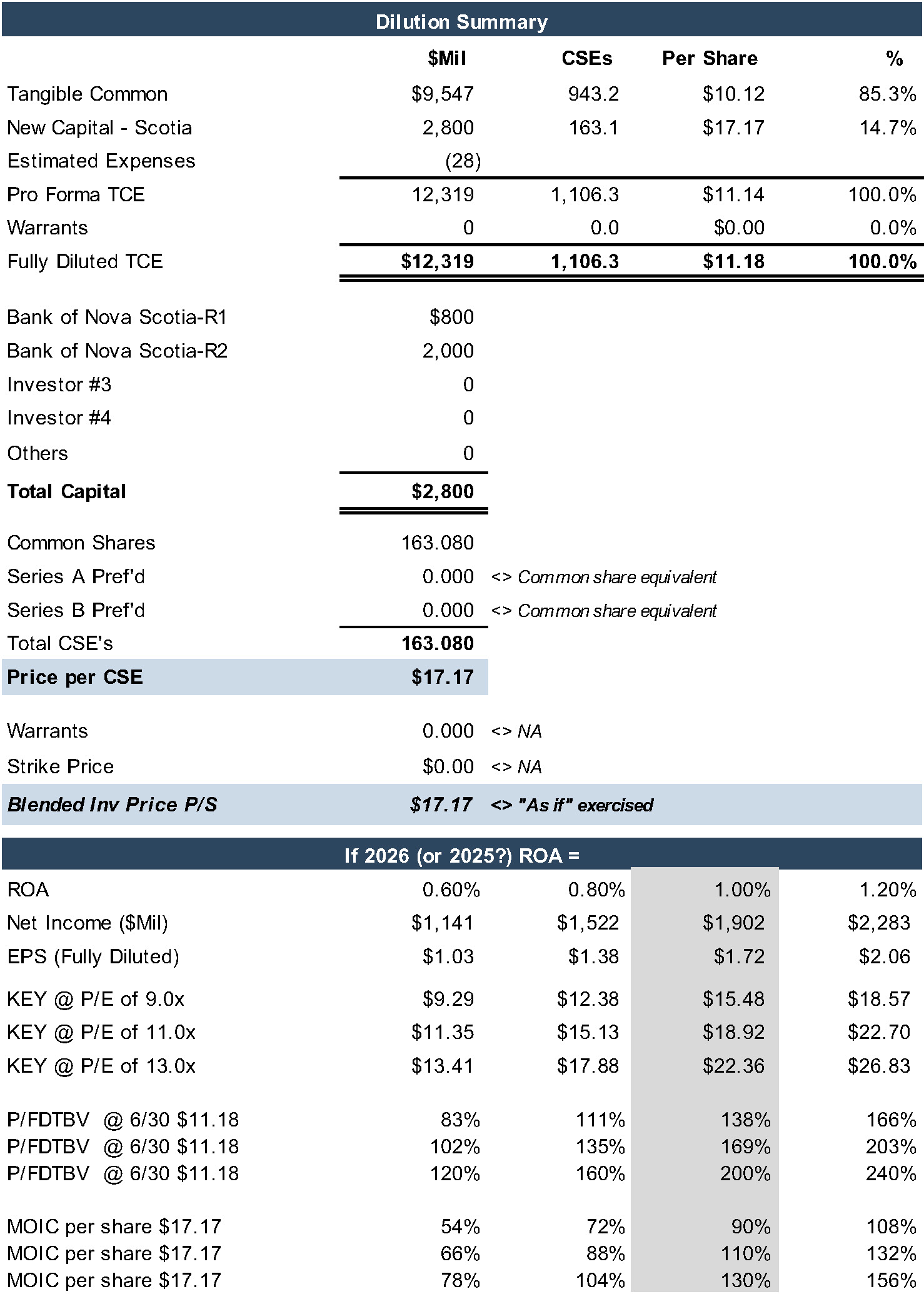
Figure 2: KEYCORP Pro Forma Balance Sheet
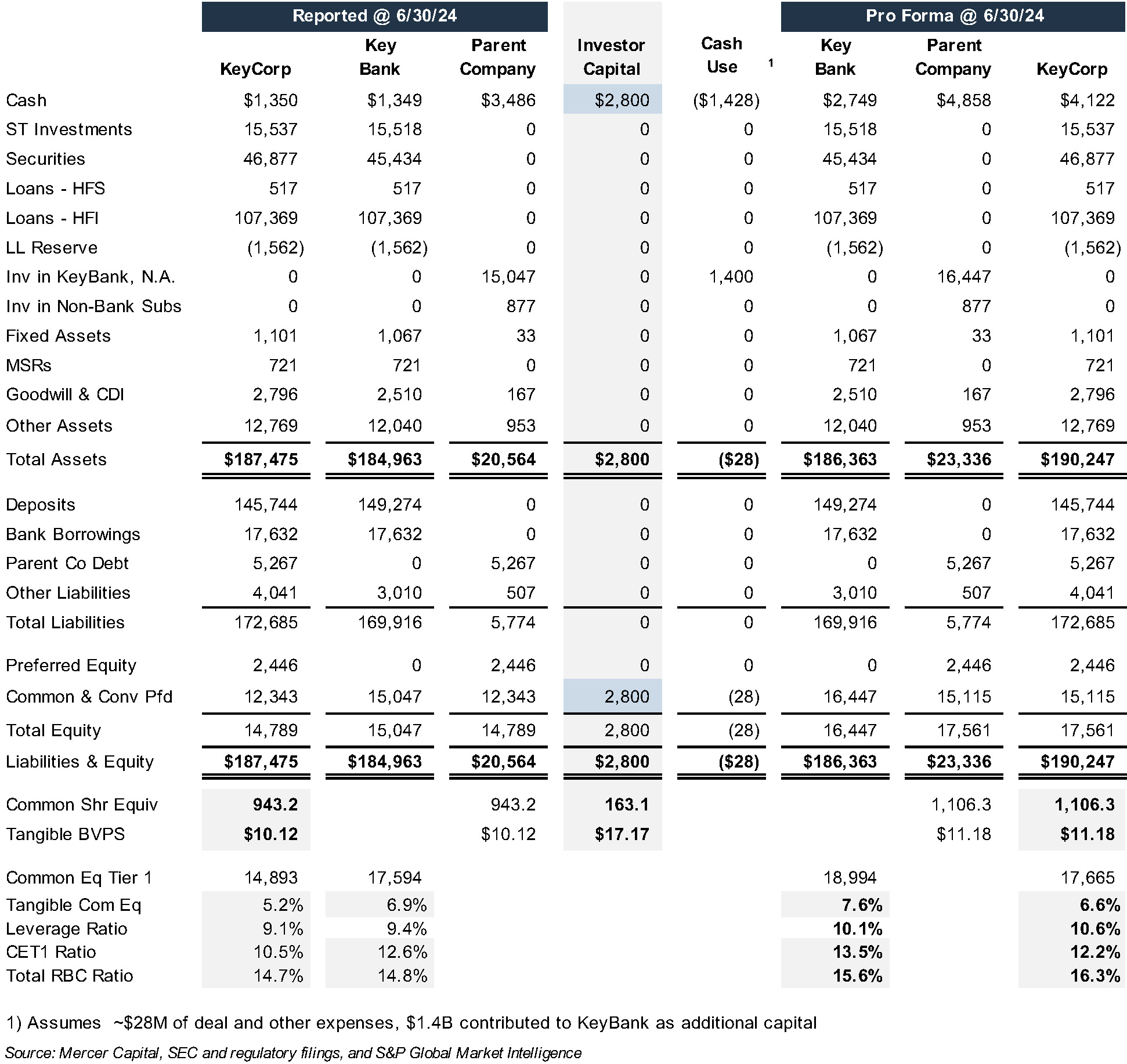
2024 Mid-Year Market Update
Year-to-date through August 23, the Nasdaq Bank Index and the KBW Nasdaq Regional Bank Index appreciated by 14% and 6%, respectively, compared to 18% appreciation by the S&P (see Figure 1). Through June, bank stocks were flat to down from year-end 2023 but rallied in July to outperform the broader market with the Nasdaq Bank Index and the KBW Regional Bank Index appreciating by 17% and 19%, respectively, compared to 1% appreciation for the S&P in the month of July.
After a period of underperformance due to earnings pressure from rising rates and falling margins, banks rallied strongly during the reporting of 2Q24 earnings in July as it became apparent NIMs for most banks had or soon would stabilize and prospectively widen as the Fed moves to reduce short-term policy rates.
Figure 1: Index Performance (12/31/2023 – 8/23/2024)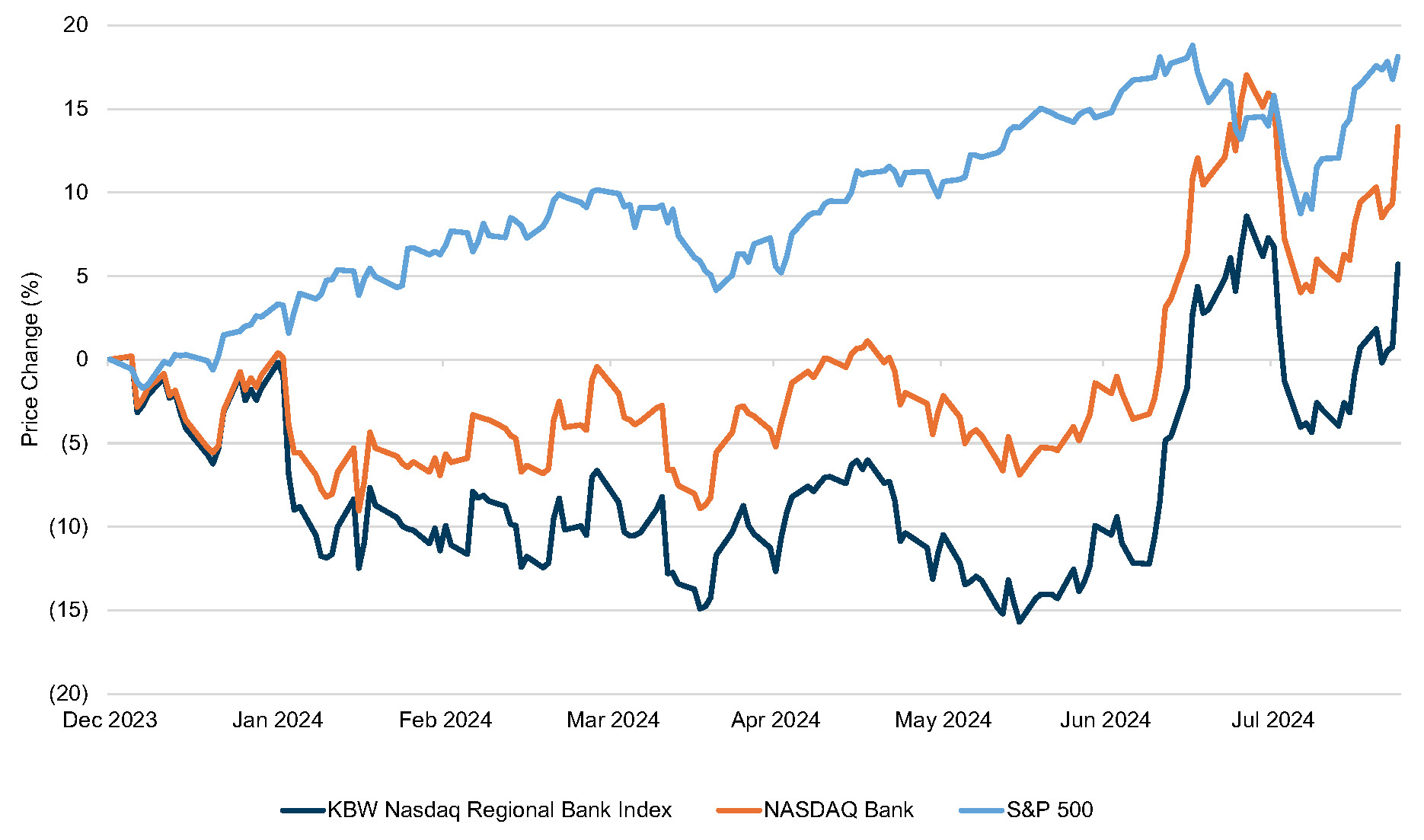 Source: S&P Capital IQ Pro
Source: S&P Capital IQ Pro
After steadily declining from a peak of 3.65% in the last quarter of 2022, the median net interest margin for all banks traded on the NYSE and Nasdaq widened by 3 bps in 2Q24 compared to 1Q24. Furthermore, as shown in Figure 2, 66% of all banks reported net interest margin expansion quarter-over-quarter, compared to just 20% in the first quarter of the year. Margin improvement was less prevalent for the biggest banks as only 32% of banks with assets over $100 billion reported net interest margin expansion in 2Q24, and the group as a whole reported median net interest margin compression of 3 bps (see Figure 3).
Figure 2: Trend in Median Net Interest Margin & QoQ Change in NIM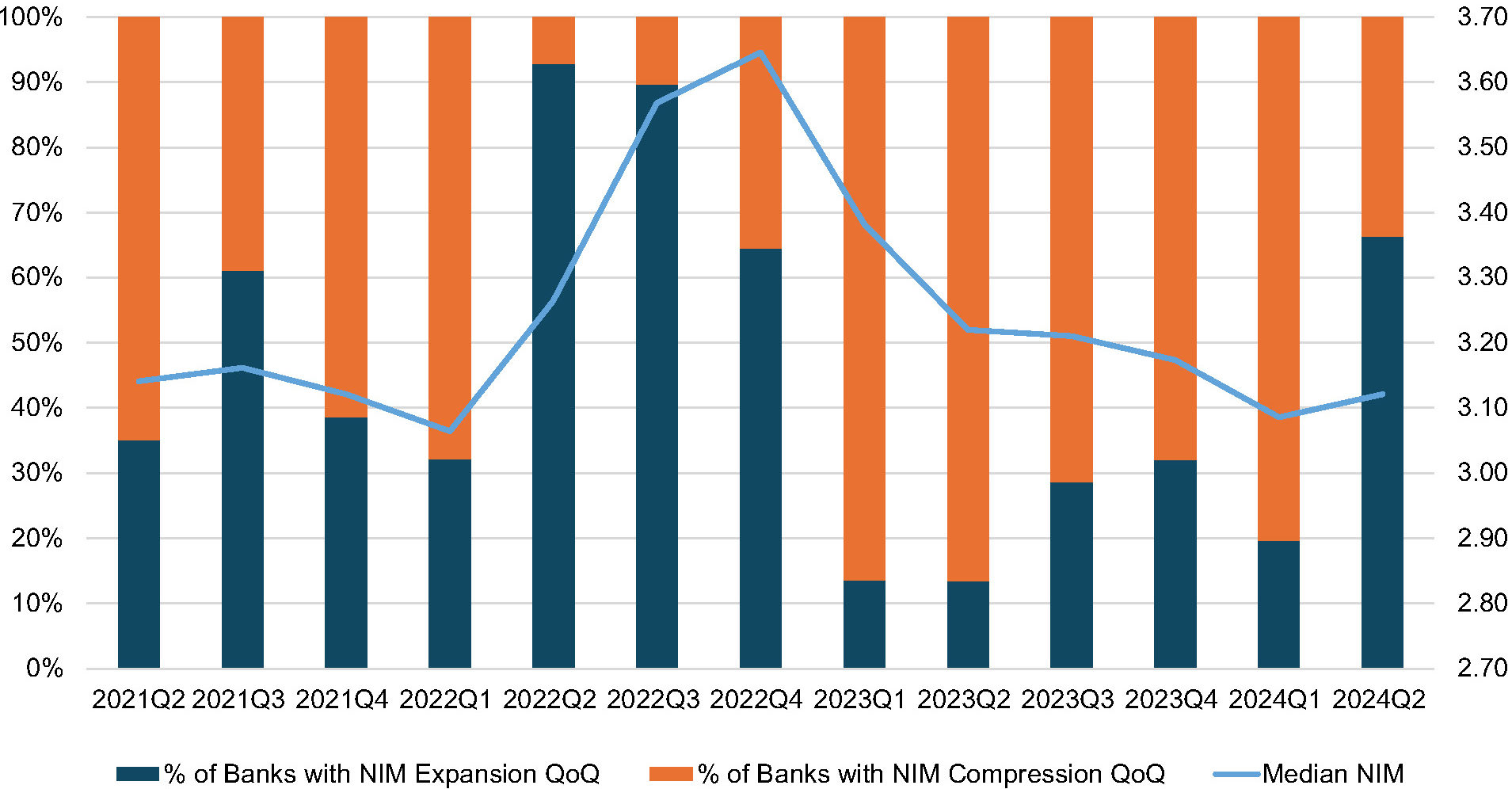
Source: S&P Capital IQ Pro, Mercer Capital Research
Stock price appreciation was greatest for the banks with total assets between $1 billion and $100 billion, in part reflecting investor optimism for earnings improvement for banks that faced the most margin compression from 4Q22 to 1Q24.
As shown in Figure 3, banks with assets less than $1 billion or greater than $100 billion reported stock price appreciation of 7%-8% from March 31, 2024 to July 31, 2024 compared to a 16% median increase for all banks.
Figure 3: Change in Net Interest Margin by Asset Size Range Source: S&P Capital IQ Pro
Source: S&P Capital IQ Pro
As illustrated in Figure 4, valuation multiples increased significantly with the rally in stock prices in July. Publicly traded banks with assets between $1 and $15 billion reported a median price/one year forward earnings multiple of 12.5x and a price/tangible book value multiple of 1.26x as of July 31, 2024, up from 10.9x and 1.06x as of June 30. In addition to higher forward P/Es, Analysts’ estimates for 2024 EPS were 12% higher as of July 31 compared to estimates for 2024 EPS available as of year-end 2023.
According to data provided by S&P Capital IQ Pro, there were 74 announced M&A transactions through August 24, compared to 102 announced transactions for the entirety of 2023. Notably, aggregate deal volume reached $9.4 billion, which exceeds the $4.2 billion in announced deals in all of 2023 as shown in Figure 5. After a period of subdued activity, the bank M&A market is showing signs of recovery. Three deals valued at over $1 billion have been announced in 2024 compared to just one in 2022 and 2023, and the median P/E multiple increased from 12.4x in 2023 to 17.1x in 2024.
Figure 4: Pricing Multiples (Banks with Assets between $1-$15 Billion) Source: S&P Capital IQ Pro, Mercer Capital Research
Source: S&P Capital IQ Pro, Mercer Capital Research
Figure 5: Deal Value and Volume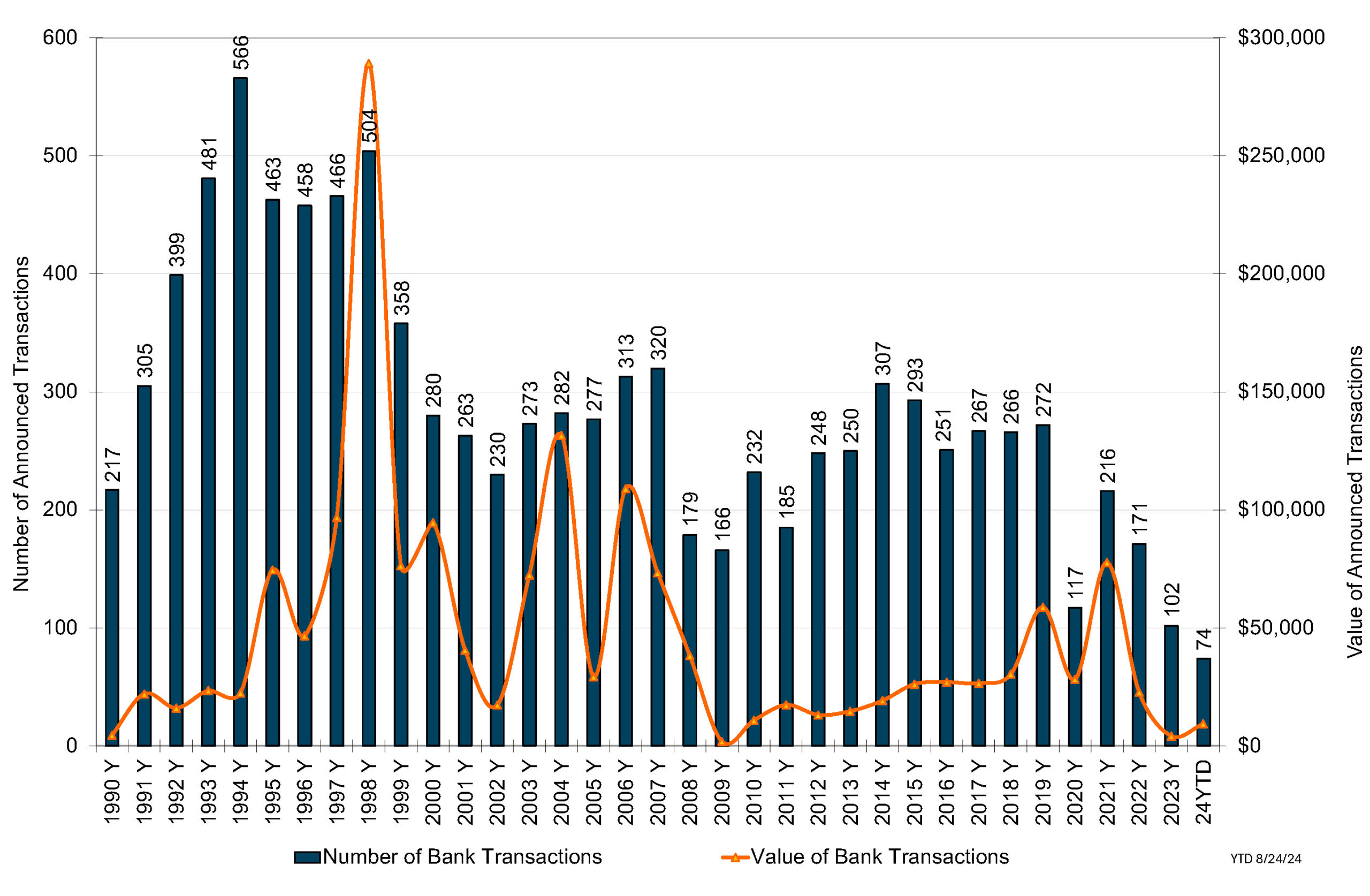 Source: S&P Capital IQ Pro
Source: S&P Capital IQ Pro
Figure 6: Long-Term Trend in Pricing Multiples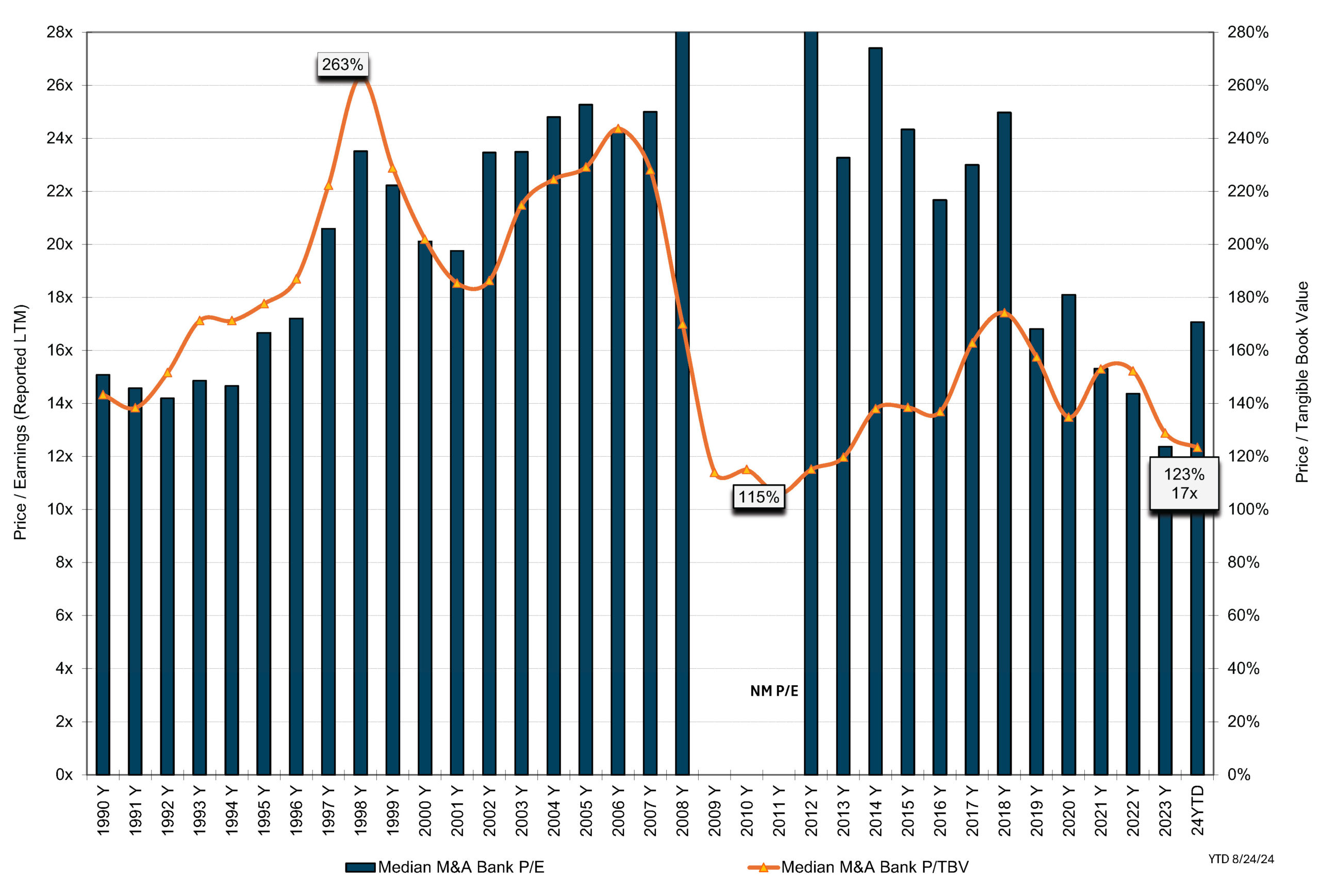 Source: S&P Capital IQ Pro
Source: S&P Capital IQ Pro
After a tumultuous period for the banking industry marked by bank failures, liquidity concerns, margin pressure, depressed valuations, and subdued M&A activity, the outlook for the remainder of 2024 is cautiously optimistic. EPS estimates are trending higher, M&A activity is showing signs of improving, and net interest margins are poised to expand. Potential deterioration in asset quality remains the dark cloud on the horizon for the banking industry as margin pressures ease alongside weakening economic conditions.
After a tumultuous period for the banking industry marked by bank failures, liquidity concerns, margin pressure, depressed valuations, and subdued M&A activity, the outlook for the remainder of 2024 is cautiously optimistic. EPS estimates are trending higher, M&A activity is showing signs of improving, and net interest margins are poised to expand. Potential deterioration in asset quality remains the dark cloud on the horizon for the banking industry as margin pressures ease alongside weakening economic conditions.
Personal Goodwill and Valuation Issues in Marital Dissolution Cases
What is personal goodwill and why is personal vs. enterprise goodwill such an important topic? How is case law relevant, and is it always relevant? We discuss practical approaches, best practices and the impact from facts and circumstances.
Economic Pressure on Commercial Real Estate Sector
Commercial real estate loans totaled ~$3 trillion across all U.S. commercial banks as of March 2024, which represents a 0.34% increase from February of 2024 and a 3% increase from March of 2023. As seen in the graph below, U.S. banks have continued to expand their CRE loan portfolio over the last ~20 years.
Due to the slowing economy as well as strong preferences for remote and hybrid-working schedules, U.S. commercial property prices decreased by 7% in the past year and 21% since their peak in March of 2022, per Green Street’s Commercial Property Price Index. The increasing number of delinquent loans surrounding commercial properties continues to be a concern for banks, increasing from $11.2 billion in 2022 to $24.3 billion in 2023. Additionally, data from MSCI notes that over $38 billion of U.S. office buildings are pressured by potential defaults and foreclosures, which represents the largest amount since the fourth quarter of 2012.
Six of the largest U.S. banks (JPMorgan Chases, Bank of America, Wells Fargo, Citigroup, Goldman Sachs, and Morgan Stanley) have experienced increases in delinquent CRE loans ($9.3 billion in 2023). CRE loans make up ~11% of the average loan portfolio at large U.S. banks, so most large banks have set aside reserves for this sector. Smaller banks, on the other hand, are further exposed as CRE loans account for ~22% of their average loan portfolios.
CRE has long been a hot topic of conversation and CRE regulatory guidance to address elevated concentrations of CRE loans and help institutions manage risk accordingly was released all the way back in 2006. Investors and potential acquirers increasingly focus on CRE concentration levels in assessing valuation and potential riskiness of an institution in today’s environment. For example, an article on S&P Cap IQ noted that investors are increasingly focused on CRE concentrations and those public banks with higher CRE concentrations (those whose CRE loan balances exceeded the 2006 CRE regulatory guidance threshold and had CRE loans above 300% of risk based capital) are experiencing lower returns and pricing multiples relative to their peers in the current environment despite having higher profitability (as measured by ROAA and ROAE and NIMs).
CRE Stress Test – Severely Adverse Scenario
For those banks with a CRE concentration, stress testing can be an important piece of risk management, and the results from the U.S. Federal Reserve’s stress test of the 31 largest U.S. banks in June of 2024 could be of interest. The stress test aimed to assess the exposure levels of large U.S. lenders during a post-pandemic era of record-high vacancy rates in commercial properties (~20%). Balance sheets of these large banks were tested with severe economic scenarios that included the following economic variables : ~36% decrease in U.S. home prices, ~55% decrease in equity prices, a ~40% decline in CRE prices, and a 10% peak unemployment rate.
On June 26, 2024, the Fed released its stress test results examining banks’ ability to continue lending to both businesses and households should a severe global recession occur. The 2024 stress test showed that the 31 largest banks in the U.S. had sufficient capital to absorb ~$685 billion in losses and continue lending to households and business under stressful conditions. These results helped to soothe many qualms surrounding the financial health of the banking industry in relation to CRE loans. While the post-stress CET1 capital ratios remained above required minimum regulatory levels throughout the projection horizon—both in the aggregate and for each bank tested—the aggregate maximum decline in the stressed CET1 capital ratio was 2.8%. This was larger than the decline in 2023 (2.5%) but within the range observed between 2018 and 2022.
For CRE loans, the projected aggregate loan losses under the severely adverse scenario for the three year stressed forecast period (2024-2026) was 8.8% of average loan balances (~2.9% annually). This was above the projected loss rate for the total loan portfolio of 7.1% (~2.4% annually) but comparable to the aggregate loan loss rate for the CRE segment in the 2023 stress test of the largest banks (which was also 8.8%).
Conclusion
It is important when performing a valuation or a stress test of a CRE portfolio to understand that CRE is a diverse asset class that ranges from office to multifamily to retail to hotel/hospitality and industrial/warehouse loans and the potential risk of loss can vary markedly from one type of CRE loan to another. Many factors such as a bank’s underwriting criteria, the property’s type and location, owner and nonowner occupied, guarantor support, historical loan performance, vintage, and occupancy rates can be important. For example, the size of the underlying property alone can impact the expected default rate of an office loan significantly. An article from the Kansas City Fed noted that expected default rates on a sample of office loans in Q4 2023 were ~25% for the largest office properties (those with more than 500,000 square feet) versus under 5% for those with less than 50,000 square feet. Thus, diligence must be taken when performing a valuation or stress test of a bank or its CRE loan portfolio.
Valuing financial institutions and stress testing can be a complex exercise, particularly for those financial institutions with a relatively high proportion of commercial real estate in their loan mix. At Mercer Capital, we have over 40 years of experience in valuing financial institutions through a variety of market and economic cycles. Please call if we can be of assistance in providing valuation or stress testing services to your financial institution.
Supreme Court Upholds Connelly
Life Insurance Proceeds and Redemption Obligations in Buy-Sell Agreements
The United States Court of Appeals, Eleventh Circuit, rendered a decision in the matter of Estate of Blount v Commissioner of Internal Revenue in October 2005.1 The primary takeaway from that decision was that life insurance used as a funding vehicle to pay a company’s liability to repurchase shares upon the death of a shareholder does not add to the value of the company for federal gift and estate tax purposes.
The United States Court of Appeals, Eighth Circuit, rendered a decision in the matter of Thomas Connelly v. United States in June 2023.2 The primary takeaway from that decision is that life insurance received at the death of a shareholder is a corporate asset that adds to the value of the company for federal gift and estate tax purposes.
Given this apparent split in the decisions of the Eighth and Eleventh circuits, the Eighth circuit’s case was offered to the Supreme Court of the United States on writ of certiorari. The Supreme Court of the United States (“SCOTUS”) rendered its decision in the matter of Connelly, as Executor of the Estate of Connelly v. United States (602 U. S. _____(2024), decision rendered June 6, 2024). The unanimous decision of the Supreme Court was rendered by Justice Thomas, who wrote in summary:
Michael and Thomas Connelly owned a building supply corporation. The brothers entered into an agreement to ensure that the company would stay in the family if either brother died. Under that agreement, the corporation could be required to redeem (i.e., purchase) the deceased brother’s shares. To fund the possible share redemption, the corporation obtained life insurance on each brother. After Michael died, a narrow dispute arose over how to value his shares for calculating the estate tax. The central question is whether the corporation’s obligation to redeem Michael’s shares was a liability that decreased the value of those shares. We conclude that it was not and therefore affirm.
I am not a lawyer and am careful when analyzing cases. However, it appears that SCOTUS wrote its decision in a very narrow fashion. It did not, for example, appear to reject the Eleventh Circuit’s decision in Blount, but affirmed the Eighth Circuit’s decision in Connelly.
At the very least, in light of the Supreme Court’s ruling, every buy-sell agreement funded by life insurance should be reviewed by competent legal and tax counsel to ensure that the agreements operate as planned when triggered.
Basic Facts of Connelly
The basic facts can be summarized as follows:
- Michael and Thomas Connelly, brothers, were the owners of Crown C Supply (“Crown” or “the Company”), a company located in St. Louis, Missouri.
- Michael owned 385.9 shares representing 77.18% of the shares outstanding.
- Thomas owned 114.1 shares representing 22.82% of the shares outstanding.
- On August 29, 2001, Michael and Thomas entered into a stock purchase agreement to ensure that Crown would stay in the family if either brother died. The agreed upon value (certificate of value) at that time was $10,000 per share, or $5 million. Under the agreement, the surviving brother had an option to purchase the deceased brother’s shares. If a brother declined to purchase, Crown would be required to purchase the deceased brother’s shares.
- The agreement called for an appraisal process to determine the fair market value of a deceased brother’s shares. Crown was to select an appraiser and the estate of a deceased brother was to select another. Both were to provide fair market value opinions. If the two appraisal conclusions were more than 10% apart, the appraisers would select a third appraiser, who would also provide an opinion of fair market value.
- Crown obtained $3.5 million of life insurance on each brother’s life, which at some point was reduced to $3 million.
- Michael died on October 1, 2013.
- At the time of Michael’s death, there was no agreed upon certificate of value.
- Thomas opted not to purchase Michael’s shares, giving rise to Crown’s obligation to purchase Michael’s shares. The parties did not engage in any appraisal process, as called for in their agreement.
- Michael’s son and Thomas agreed in an “amicable and expeditious manner” that Michael’s shares were worth $3,000,000 (77.18% x $3,860.000 = $2,978,148) of an agreed upon value of $3,860,000). The purchase price resulted from what was described as an extensive analysis of Crown’s books and an extensive analysis of assets and liabilities of the company. Thomas, an experienced businessman extremely knowledgeable about Crown’s finances, was able to ensure an accurate appraisal of the shares.3
- Note the $3 million purchase price for Michael’s shares implied a value for 100% of Crown of $3.86 million ($3,000,000 / 77.18%). Recall that the certificate of value agreed upon in 2001 provided a value of $5,000,000 for Crown, or significantly higher than the agreed upon $3.86 million.
- Crown collected the life insurance proceeds and purchased Michael’s shares for ~$3,000,000, and Michael’s estate filed an estate tax return based on this value.
- The IRS audited the estate’s return and claimed a deficiency of $889,914, or 38.4% of the difference between $5,294,458 (life insurance is a corporate asset) and $2,978,148 (life insurance is a funding vehicle).
- Interestingly, there is no record of an appraisal conducted on behalf of the IRS. During the audit, the Company retained an accounting firm to provide an appraisal. The concluded fair market value, assuming that the obligation to repurchase Michael’s stock was a real liability, was $3.86 million.
- Reading between the lines in the earlier decisions, it seems that the IRS was more interested in challenging the use of life insurance proceeds as a funding vehicle rather than as a corporate asset. The case leaves a big question regarding the actual fair market value of Crown on the date of Michael’s death.
- Michael’s estate paid the deficiency, and Thomas, as executor, sued the United States for a refund.
- The District Court (Eighth Circuit) granted summary judgment to the Government, holding that to accurately value Michael’s shares, the $3 million in life insurance proceeds must be counted in Crown Supply’s valuation.4
- The Eighth Circuit affirmed.
- SCOTUS, in a unanimous decision written by Justice Thomas, affirmed the decision of the Eighth Circuit Court of Appeals.
Justice Thomas wrote:
The dispute in this case is narrow. All agree that, when calculating the federal estate tax, the value of a decedent’s shares in a closely held corporation must reflect the corporation’s fair market value. And, all agree that life insurance proceeds payable to a corporation are an asset that increases the corporation’s fair market value. The only question is whether Crown’s contractual obligation to redeem Michael’s shares at fair market value offsets the value of life insurance proceeds committed to funding that redemption.
Whether the SCOTUS decision in Connelly is the death knell of entity repurchase agreements is a question. However, the decision will raise questions and should require every company with company-owned life insurance on the lives of its owners to evaluate the effectiveness of their buy-sell agreements and related life insurance.
SCOTUS Example of a Redemption
Justice Thomas wrote:
An obligation to redeem shares at fair market value does not offset the value of life insurance proceeds set aside for the redemption because a redemption does not affect any shareholder’s economic interest. (at pp. 6-7) (emphasis added)
Following this statement, an example is provided in the text of the decision. We examine this example more visually in the analysis that follows. We call the hypothetical company in the decision “SCOTUS Example Co.” The initial balance sheet and ownership of SCOTUS Example Co. are shown in Figure 1.
Figure 1

Click here to expand the image above
SCOTUS Example Co. has $10,000,000 in cash/operating assets. Owner A holds 80% of the stock which is worth $8,000,000. Owner B owns 20% of the stock, which is worth $2,000,000.
We assume that Owner B dies (and there is no life insurance) or that the Company simply redeems his 20% interest for $2,000,000. The Company retires Owner B’s shares to treasury, and now there are only 80 shares outstanding. The effect of this is to remove Owner B as a shareholder, lower the Company’s value by $2,000,000, and elevate Owner A to ownership of 100% of the shares now outstanding. The remaining $8,000,000 value of the Company plus the $2,000,000 in Owner B’s estate amount to $10,000,000, or exactly the value before the redemption of Owner B’s shares, as seen in Figure 2 .
Justice Thomas then concluded:
The value of the shareholders’ interests after the redemption – A’s 80 shares and B’s $2 million in cash – would be equal to the value of their respective interests in the corporation before the redemption. Thus, a corporation’s contractual obligation to redeem shares at fair market value does not reduce the value of those shares in and of itself.
It is an incorrect conclusion to suggest that the example redemption “does not affect any shareholder’s economic interest.” It is true that Owner B received the $2.0 million value of his shares in the example. Owner A’s interest, while still valued at $8.0 million as before the redemption, now represents a 100% interest in a smaller company. Owner A’s economic interest has, indeed, changed. Instead of owning the right to 80% of the economic benefits of the pre-redemption company, he now owns the rights to 100% of the economic benefits of a company that is different (smaller) than before.
Figure 2

Click here to expand the image above
There is a significant leap from the SCOTUS example to Justice Thomas’s conclusion. There is no life insurance in the example, yet it is the life insurance that is assumed to increase the value of Crown. We examine the case to understand the presumed reduction in value (or not) inferred in this conclusion.
Is Life Insurance a Corporate Asset or Is it a Funding Vehicle?
There are two opposing treatments of life insurance proceeds in valuations for purposes of buy-sell agreements. As I wrote in 2010 in a book about buy-sell agreements:5
Treatment 1 – Proceeds are a funding vehicle and not a corporate asset. One treatment would not consider the life insurance proceeds as a corporate asset for valuation purposes. This treatment would recognize that life insurance was purchased on the lives of shareholders for the specific purpose of funding a buy-sell agreement. Under this treatment, life insurance proceeds, if considered as an asset in valuation, would be offset by the company’s liability to fund the purchase of shares. Logically, under this treatment, the expense of life insurance premiums on a deceased shareholder would be added back to income as a nonrecurring expense.
Treatment 2 – Proceeds are a corporate asset. Another treatment would consider the life insurance proceeds as a corporate asset for valuation purposes. In the valuation, the proceeds would be treated as a nonoperating asset of the company. This asset, together with all other net assets of the business, would be available to fund the purchase of shares of a deceased shareholder. Again, under this treatment, the expense of life insurance premiums on a deceased shareholder would be added back to income as a nonrecurring expense.
The Internal Revenue Service in Connelly treated the life insurance proceeds as a corporate asset to be added to value in the determination of fair market value. This is Treatment 2 above. Michael’s estate argued that the life insurance proceeds should be treated as a funding vehicle to finance the redemption of a shareholder’s shares upon his death, which is Treatment 1 above (and, effectively, the conclusion in Blount).
SCOTUS Treatment of Life Insurance Proceeds
Using the same T-account analysis as with the discussion of SCOTUS Example Co. and a simple redemption, we now look at the effective treatment employed by the Internal Revenue Service and SCOTUS.
Accept as given that Crown had an operating value of $3.86 million (per the opinion), which is shown in the market value balance sheet at the top of Figure 3. Michael owned 77.18% with a value of $2,979,148 and Thomas owned 22.82% with a value of $880,852. These values represent their respective shares of the $3,860.000 of operating value.
Figure 3
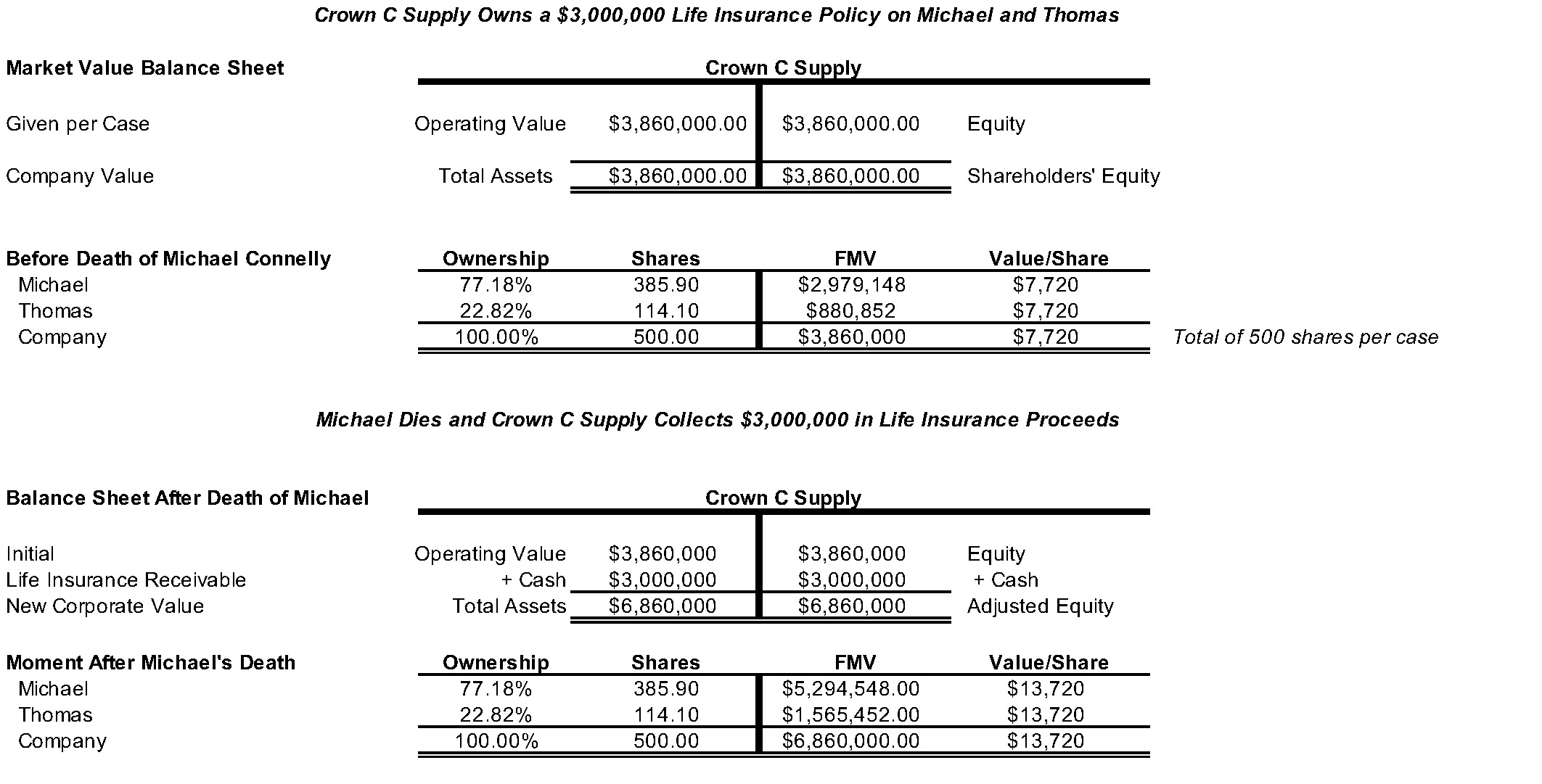
Click here to expand the image above
Now we examine the balance sheet after Michael’s death. The life insurance of $3,000,000 (receivable) is added to the balance sheet as an asset and as equity, raising the total value of the Company to $6.86 million. Michael’s shares were worth $5,294,548 and Thomas’s shares were worth $1,565,452. In both cases, their values per share had risen from $7,720 per share to $13,720 per share, or $6,000 per share ($3,000,000 of life insurance divided by 500 shares outstanding).
In the “Syllabus” released with SCOTUS’s Connelly decision, we see the root of the confusion.6
Thomas’s argument that the redemption obligation was a liability also cannot be reconciled with the basic mechanics of a stock redemption. He argues that Crown was worth $3.86 million before the redemption, and thus, that Michael’s shares were worth approximately $3 million ($3.86 million x 0.7718). But he also argues that Crown was worth $3.86 million after Michael’s shares were redeemed. See Reply Brief 6. Both cannot be right. A corporation that pays out $3 million to redeem shares should be worth less than before the redemption.
Finally, Thomas asserts that affirming the decision below will make succession planning more difficult for closely held corporations. But the result here is simply a consequence of how the Connelly brothers chose to structure their agreement. (Pp. 5-9)
The implicit assumption behind this reasoning is that the value of Crown was $6.86 million before the redemption. However, the fair market value of Crown was $3.86 million before Michael’s death. We finish the example in Figure 4.
The problem is that Crown was not worth $6.86 million until the moment after Michael’s death. However, it was only after his death that the life insurance receivable, which was a contingent asset, available to Crown came into being. And after his death, the contingent liability to redeem his shares was also triggered.
In Figure 4, the redemption, given the new value of $6.86 million, did reduce the value of Crown by $5,298,548, or Michael’s share of that value. Thomas, on the other hand, experienced an increase in value from before Michael’s death ($880,852, or $7,720 per share) to the post-redemption value of $1,565,452, or $13,720 per share. His value increased because he benefited from his 22.82% of the life insurance proceeds (22.82% x $3,000,000) of $684,600. When this is added to his original value of $880,852, his post redemption value is $1,565,452, and his ownership rose from 22.18% to 100% because of the redemption of Michael’s shares.7
Figure 4
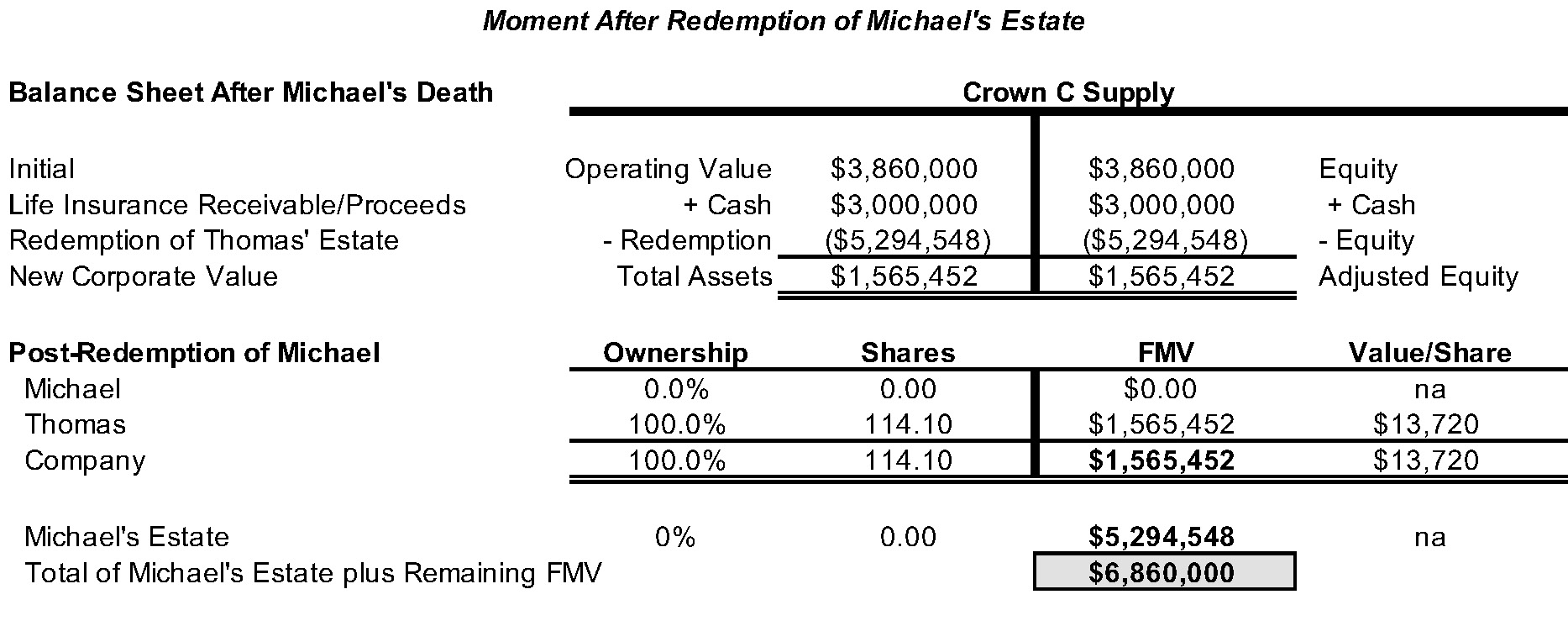
Click here to expand the image above
SCOTUS treated the life insurance on Michael’s life as a corporate asset and essentially assumed that this asset was available to the shareholders, while ignoring the contingent liability that Crown had to redeem Michael’s shares.
Presumably, Crown would have to use existing assets of $2.3 million (or borrow funds) to achieve the redemption. This would leave the Company in an undercapitalized state post-redemption with only $1.565 million of capital because the life insurance proceeds were included in the value of the Company. This is precisely the situation that the life insurance proceeds were supposed to have precluded.
Michael’s Estate Treated Life Insurance as a Funding Vehicle
For clarity, we repeat the initial position of Crown before Michael’s death in Figure 5.
Figure 5
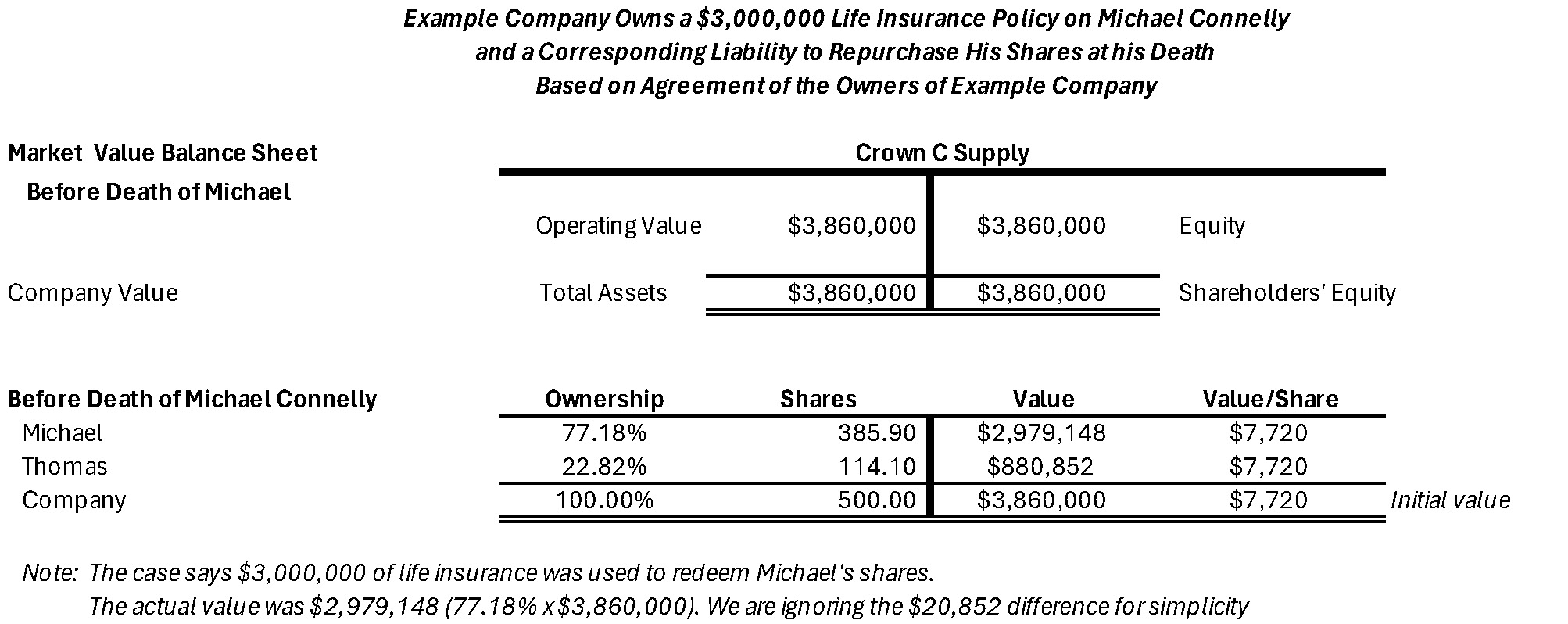
Click here to expand the image above
Crown was stated to have a fair market value of $3.86 million, divided between the shareholders as discussed previously and shown in Figure 5. Upon Michael’s death, the life insurance policy was triggered, and Crown had a receivable and then proceeds of $3.0 million.
Simultaneously, Crown’s contingent liability to redeem Michael’s shares was triggered. What happens, essentially, happens off-balance sheet, as seen in Figure 6.
Figure 6

Click here to expand the image above
At this point, we see that both the contingent asset (life insurance proceeds) and the contingent liability (to purchase Michael’s shares) are used to offset each other. This is how well-written buy-sell agreements have operated for many years. There is most often an appraisal process to determine fair market value, but this was ignored by Michael’s estate and Thomas.
Crown received $3.0 million of proceeds and paid out $3.0 million to satisfy the matching liability.
We now examine the impact of these off-balance sheet transactions on Crown, Michael’s estate, and Thomas, as the remaining owner, in Figure 7.
Figure 7

Click here to expand the image above
Reading the Eighth Circuit’s opinion on Connelly and now the SCOTUS opinion, the judges and justices seemed to think there was some skullduggery on the part of Crown and Michael’s estate. There was not. What the parties were guilty of was not following their own procedures. They did not have a certificate of value to establish the price for Michael’s redemption, as their agreements called for.
Then, when Thomas did not purchase Michael’s shares, the parties did not follow the valuation process called for in their buy-sell agreement. They cobbled together a non-independent valuation.
Had Thomas, Crown, and Michael’s estate followed their own planning, the overall result could have been significantly different.
A part of the quotation above from the “Syllabus” to the SCOTUS opinion is repeated for emphasis.
Thomas’s argument that the redemption obligation was a liability also cannot be reconciled with the basic mechanics of a stock redemption. He argues that Crown was worth $3.86 million before the redemption, and thus, that Michael’s shares were worth approximately $3 million ($3.86 million x 0.7718). But he also argues that Crown was worth $3.86 million after Michael’s shares were redeemed. See Reply Brief 6. Both cannot be right. A corporation that pays out $3 million to redeem shares should be worth less than before the redemption. (bold emphasis added)
As shown here previously, Crown could, in fact, be worth $3.86 million before the redemption of Michael’s shares for $3.0 million and after the redemption, as well. Crown received $3.0 million in life insurance proceeds (the contingent asset) that were used to satisfy the redemption of Michael’s shares (the contingent liability).
There is a similar analysis of the two treatments of life insurance for buy-sell agreements in Buy-Sell Agreements for Closely Held and Family Business Owners.8
Closing Observations
The estate planning world is keenly focused on the SCOTUS decision in Connelly. Does the decision render entity-purchased life insurance useless, or at least, less useful than before? In the short time since the decision was rendered, much has been written and said about the impact of the decision.
Readers of this article will need to examine that literature in the context of future planning for buy-sell agreements and for the reexamination of existing agreements. It is too soon to tell the ultimate impact of this important decision.
ENDNOTES
-
Estate of Blount v. Commissioner of Internal Revenue Service (2005), United States Court of Appeals, Eleventh Circuit, No. 04-15013, October 31, 2005.
-
Connelly, as Executor of the Estate of Connelly v. United States, No. 21-3683 (8th Cir. 2023), decision rendered June 2, 2023.
-
Connelly v. United States, Memorandum and Order, page 21, September 2021. It is clear from all the decisions that no court considered Thomas to be a business appraiser, regardless of his “experience.”
-
Connelly, as Executor of the Estate of Connelly v. United States, No. 21-3683 (8th Cir. 2023), decision rendered June 2, 2023.
-
Mercer, Z. Christopher Mercer, Buy-Sell Agreements for Closely Held and Family Business Owners (Memphis, Peabody Publishing, LLC, 2010)
-
Connelly v. United States, No. 23-146, Syllabus at 2-3 (U.S. June 6, 2024). https://www.supremecourt.gov/opinions/23pdf/23-146_i42j.pdf.
-
Given the timing of things, Crown turned out better off than the example. Crown received $3.0 million in life insurance proceeds and paid $3.0 million for Michael’s stock. The net worth of the Company after the redemption was $3.86 million. Recall that Michael’s estate paid $0.9 million in estate taxes. It would appear that Michael’s estate received $3.0 million for his shares of Crown. The estate also paid the additional interest demanded by the Internal Revenue Service. That tax was $889,914. The net effect is that Michael’s estate paid taxes on $5,294,548 of value, received $3.0 million for his shares, and had net assets after tax of $2.1 million. The net result is that Crown retained the $2.3 million of extra consideration that the case says it should have paid, leaving the Company with a net worth of $3.86 million ($1.565 million + $2.295 million. The real loser in all this was Michael’s estate.
-
Ibid, Chapter 15.
Personal vs. Enterprise Goodwill: Issues to Consider in Divorce Valuations
This article discusses important concepts of personal vs. enterprise goodwill in valuations for divorce. It is important to understand the business, industry, and efforts of the divorcing spouse(s) & non-divorcing parties to perform a thorough, supportable analysis. It is also important to know how each state treats personal goodwill – some states consider personal goodwill to be a separate asset, and some do not make a specific distinction for it and include it in the marital assets. Additionally, while there are several accepted methodologies for determining % allocations to personal vs. enterprise, there are not uniform standards nor guidelines that govern the how-to’s; as such these analyses are complex and require subject matter expertise.
What Is Goodwill?
Goodwill is the difference between the value of a business less its tangible net assets such as fixed assets. Goodwill is synonymous with intangible assets, and the value of a business is the value of tangible assets + value of intangible assets. Some of the intangible assets can be separated and valued, such as assembled workforce; others fall into the catch-all goodwill category.
What Is Personal Goodwill?
Personal goodwill generally is interpreted as representing attributes that are unique to, and inseparable from, an individual, not able to be transferred. The other portion of goodwill, referred to as enterprise or business goodwill, generally is interpreted as representing value that is owned and/ or that has been created by an enterprise and that can be transferred.
Attributes typically classified within the personal goodwill category include the following:
- Personality
- Reputation
- Personal skill, expertise and knowledge
- Personal relationships
In essence, personal goodwill is represented by certain attributes that are deemed to be incorporated into the very being of an individual, and, therefore, are unable to be sold or transferred to another individual.
What Is Enterprise Goodwill?
Identifiable intangible assets typically classified within the enterprise goodwill category include the following:
- Trademarks and trade names
- Patented and unpatented technology
- Copyrights
- Customer lists and relationships (patient files/records)
- Contracts (employment, noncompete agreements)
- Phone number
- Leasehold
- Trained and assembled workforce
- Location
Why and How Is Personal Goodwill Important?
Many states identify and distinguish between personal goodwill and enterprise goodwill, and further allocate that . This may have a significant impact on the division of the marital estate. However, beyond the business valuation and division, the income derived from the personal goodwill may still be factored into division and/or future support, depending on the state.
Is Personal Goodwill More Common in Professional Services Industries?
Yes – personal goodwill tends to be more prevalent in certain industries than others and varies from matter to matter. The concept of personal goodwill is easier identified and more prevalent in professional service industries such as law practices, accounting firms, and physician practices. Does that mean it doesn’t apply to other industries such as retail, manufacturing, transportation, etc? In order to evaluate the potential carve-out of personal goodwill in an industry/business, the owner/ principal would have to exhibit a unique set of skills that specifically translates to the heightened performance of their business, unable to be transferred to another person/business.
The Goodwill Transition from Personal to Enterprise, Relative to Business Size
The image below illustrates the relationship of changing attributes of business size relative to proportion personal versus business/enterprise goodwill.
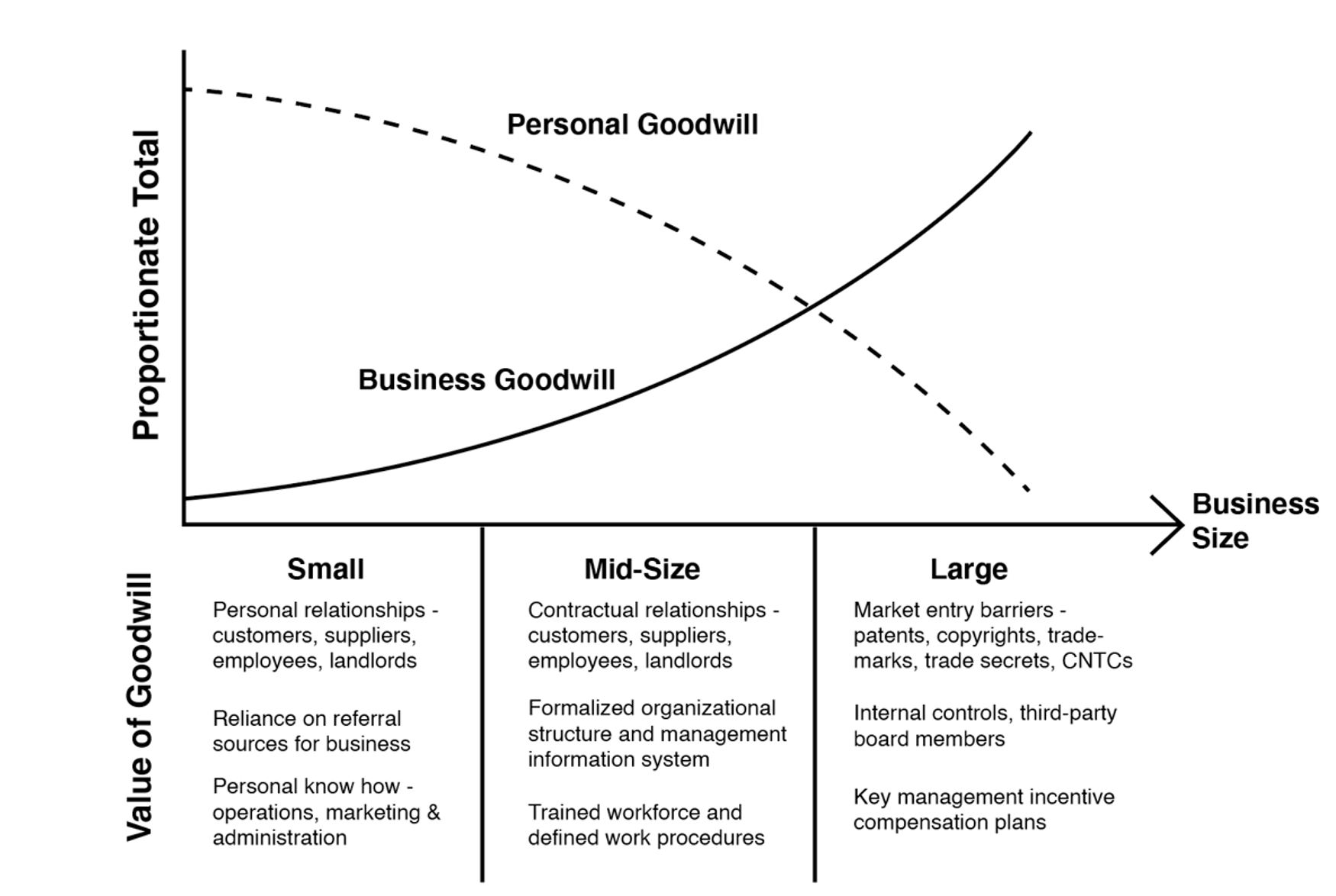
Source: BVR’s Guide to Personal v. Enterprise Goodwill
The inverse relationship between business size and percentage allocation makes intuitive sense. One person can only work so much, and their personal impact cannot be scaled like an enterprise, increasing the value attributable to the platform, i.e. the business itself.
Conclusion
There is no one-size-fits-all methodology or approach to allocating personal vs. enterprise goodwill. It will depend on the industry, history of the company, and relative contributions of the divorcing spouse(s) as well as contributions of all other employees, among other factors. From a theoretical perspective, personal goodwill should show the difference in value of the business with and without the contributions from the divorcing party. Personal goodwill has become a common battleground and the need for supportable analyses and subject matter expertise can greatly assist the marital dissolution process. Mercer Capital has extensive experience in this complex topic across various industries and business sizes.
Essential Financial Documents to Gather During Divorce
We have written about the benefits of hiring an expert in family law cases, whether it’s expected to settle or go to trial.
This booklet is designed to be a resource that will assist you and your clients during one of the most difficult times in their lives, both emotionally and financially.
Mercer Capital has compiled a list of financial documents that are typically needed in the divorce process and decoded common financial terms helpful to attorneys and their clients.
Financial experts can assist in determining the relevant documents based on the facts and circumstances of the case, which can reduce the burden of hunting down extraneous documents.
Most financial documents fall into one (or multiple) of the following categories, so we have organized this booklet to address each:
- Determining the value of the marital estate (aka marital balance sheet or net worth), and the individual assets and liabilities which comprise such
- Determining income and expenses for spousal and/or child support (akin to an income statement or budget)
- Determining the value of the business(es) or business interest(s)
- Providing support for forensic services
This information originally appeared in Mercer Capital’s Family Law Valuation and Forensics Insights newsletter, a monthly publication distributed by email as well as located on our website. Mercer Capital is a national business valuation and advisory firm and we provide expertise in the areas of financial, valuation, and forensic services.
To download the complimentary PDF, click “Add to Cart” or you can click here.
How Does a Quality of Earnings Report Differ From an Audit?
A quality of earnings (“QoE”) report and an audit are both essential tools in the business world, but they serve distinct purposes and offer varying insights. Audits are broader and regulatory in nature, whereas QoE analyses are more focused and strategic, catering to the needs of investors and decision-makers who require a deeper understanding of a company’s true financial health and future potential.
Purpose
The purpose of an audit is to form an opinion as to whether the financial statements are fairly presented in conformity with appropriate accounting principles. An audit is not intended to look at business trends and the future outlook of the company. These engagements provide assurance that financial records are free from material misstatements.
While an audit provides general assurance of financial statement accuracy and compliance, a QoE analysis offers a nuanced evaluation of the earnings’ quality and sustainability.
“Quality of earnings” is a term that refers to the overall health and sustainability of a company’s earnings, typically evaluated as part of the due diligence process in a merger or acquisition transaction. The objective of a quality of earnings report is to “translate” historical financial information into a relevant picture of earnings and cash flow that is useful in developing a credible view through the windshield.
For sellers, an independent QoE report is vital to advancing and defending their asset’s value in the marketplace. For buyers, a QoE analysis is a cornerstone of their broader diligence efforts to avoid overpaying for earnings that are not sustainable.
Scope
The scope for a quality of earnings analysis will typically take the form of “Agreed Upon Procedures” that includes financial review of company performance, and analyses that focus on earnings, cash flow, non-recurring revenue and expense, working capital, net fixed assets, and other relevant attributes.
A quality of earnings report diverges from the sole financial scope of an audit and considers key operating metrics, sustainability of the business, potential uncovered risks, as well as the impact non-financial aspects may have on earning power, to create a more accurate picture of a company’s financial health.
QoE reports analyze the underlying factors driving earnings, identifying different adjustments that might need to be made to the historical earnings to identify a measure of pro forma run rate earnings that is relevant to buyers and sellers. These adjustments can be classified into discretionary expenses, nonrecurring items, timing / accounting policy adjustments, major customer adjustments, and M&A run rate adjustments.
In contrast, audits assess the reliability of a company’s historical financial records. The process involves testing transactions, verifying account balances, and assessing internal controls. The scope of each individual audit, as well as items like overall materiality and tolerable misstatement, is determined during the planning stage.
The scope of an audit will differ for a financial audit and an integrated audit. An integrated audit includes a financial audit (audit of the financial statements) as well as an audit of internal control over financial reporting. For an integrated audit, the auditor will design tests of controls to obtain sufficient evidence to support the opinion on internal control over financial reporting and support the auditor’s control risk assessments for the audit of financial statements.
Perspective
An audit focuses on reported earnings in accordance with generally accepted accounting principles (“GAAP”). GAAP earnings are backward looking: they report how a business has performed in the past under specific rules.
Although quality of earnings analyses are developed based on historical financial statements, the main focus is on the economic earnings of the business on a normalized going-forward basis. Credible perspectives on the future must be grounded in a reliable base of historical information. However, not every dollar of GAAP earnings is equally relevant to establishing that base. Buyers and sellers care about the view through the windshield, not the rearview mirror.
Reporting & Timing
The outcome of an audit is an audit report, which expresses an opinion on whether the financial statements are free from material misstatement. Audit engagements are typically conducted annually and are often required by law or regulation, especially for publicly traded companies.
Depending upon the size of the proposed transaction and requested procedures, the timing of a QoE report can range around 45-60 days. The report itself will contain sections including Executive Summary, Quality of Earnings Analysis, Income Statement Analysis, Working Capital Analysis, as well as accompanying Excel exhibits. Included are assumptions, limiting conditions, and the scope of services provided. The report and procedures performed are tailored to the user of the report and the needs of the engagement.
Conclusion
A QoE report analyzes the company to assess sustainable earnings on a going-forward basis, while an audit forms an opinion as to whether the historical financial statements are fairly presented in conformity with appropriate accounting principles.
A comprehensive QoE analysis helps investors and shareholders understand the true economic performance and future earning potential of a business, offering a more nuanced view that extends beyond the scope of a traditional audit.
Highlights from the 2024 AAML National Family Law Conference
Ingredients for an Expert
We were proud to sponsor and attend the AAML’s inaugural National Family Law Conference in Nashville, Tennessee on May 16-18, 2024. As usual, the sessions and attendees did not disappoint. The full program can be found here.
Our biggest takeaway was that successful cases include the right recipe: the right attorney and the right expert – essentially, the right team.
But how do you choose the right team? A former colleague taught me the “good, fast, cheap principle.” This is a useful tool to use when discussing fees whether you are the family law attorney talking with clients or the valuation and/or forensic expert talking with attorneys or other referral sources.
We all know this principle – if you want it good and fast, it won’t be cheap. If you want it cheap and fast, it won’t be good.
Let’s focus on three sessions of note with this principle in mind:
- The Art of Attraction: Drawing Clients, Referrals & Profits to Your Family Law Practice
- Christopher C. Melcher, Esq., Walzer Melcher & Yoda, LLP, Jim Mueller, Esq, Verner Brumley Mueller Parker, Darrin Sennott, Scorpion
- Business, Bucks & Breakups: Mastering Business Valuations & Leveraging Your BV Expert in Divorce
- Neil Beaton, CPA/ABV, CFA, ASA, Alvarez & Marsal, Scott M. Mann. Esq, Mann Tucker Muir Gordon, LLC, Z. Christopher Mercer, FASA, CFA, ABAR, Mercer Capital, Amanda S. Trigg, Esq., Cohn Lifland Pearlman Herrmann & Knopf
- Crypto, Cash and Concealment: Finding and Tracing Hidden Assets in Divorce
- Neil Beaton, CPA/ABV, CFA, ASA, Alvarez & Marsal, Alex Krasnomowitz, CPA, CVA, MBA, Smolin Lupin, Thomas J. Sasser, Esq., Sasser Cestero & Roy, P.A.
The Art of Attraction
While the focus of this presentation centered on drawing clients, referrals, and profits to the family law practice of attorneys, the key themes also apply to assembling the entire team for a family law engagement, including the selection of the expert(s). The session also provided marketing and business development takeaways for many client-interfacing professional industries. The presenters focused on the principle of “Know, Like, Trust.” The ideal expert will exist at the intersection of all three of these concepts. Let’s examine each of the three components from the angle of working with a financial expert.
Know
There’s truth in the saying “it’s all in who you know.” The concept of “Know” is two-pronged: relationships and awareness. Relationships are the living, breathing network of all service professionals. Nurturing involves making consistent and intentional efforts to maintain existing relationships, while also finding time to create and form new relationships. These activities can be challenging during periods of heavy case load work. But just like withholding water from a plant for a few months, letting these relationships lie dormant for months at a time may lead to their decline and worse, death. Focusing on primacy and recency can reinforce these referral relationships.
The second phase of the “know” concept is awareness. Just knowing people is only part of the equation and may limit opportunities to only those within your own network. Building awareness of you and the services you provide (as well as awareness of your firm and the services of the firm) expands your network and allows opportunities to grow exponentially. The visual image here is instead of fishing with one pole in the water, by focusing on awareness, you are fishing with hundreds of poles in the water. You can imagine the difference in results in those two scenarios. The presenters offered the tip to make a goal to connect with one new person a week, this can lead to over 50 new connections in one year.
Like
Divorce cases can be high stress with uncomfortable conversations at times and are not for the faint of heart. Just as the likeability of our co-workers is a major influence on our satisfaction at work, the team for a family law engagement should consider the likeability factor. These engagements require the individuals to spend considerable time together so when faced with a choice of two equally qualified experts, why not choose the one that you actually enjoy working with?
Trust
Finally, attorneys hire experts whose professional reputation, judgement, work product, character, and abilities in depositions, mediations, and/or court they can trust. Building a professional reputation involves credibility, competency, exercising professional judgement, holding the proper credentials, and having deep experience. Many attorneys develop a personal relationship with an expert from working together on different cases and, thereby, know and trust the capabilities and character of the expert. That personal relationship can be an important deciding factor in choosing the expert.
The ability of the expert to communicate effectively is also important. Litigation can involve high-stress work with complex concepts under tremendous pressure and compressed timelines. While an expert’s work product is fact-based, effective experts take those facts and craft them into an understandable story for the mediator or judge. Think of it as the ability to summarize complex topics into smaller digestible spoonfuls of information. You can have the smartest expert with the most thorough analysis and complex conclusions, but if he/she can’t communicate it at a layperson’s level, all of that hard work risks getting lost in the mix.
Effective experts are also diligent, both in communication and in the work. Follow-through is important as well. Imagine the height of a case as a crisis, attorneys want experts that will be in the proverbial ditch with them, following through and doing what they say they will do when they say they will do it.
Pulling It Together
Unlike the “good, fast, cheap principle,” attorneys aren’t satisfied with the notion of picking two and not having all three. Let’s analyze. If you know someone and you trust them, but don’t like them, how does that play out? The hired gun in a particular market comes to mind here. He/she might be a veteran expert that everyone knows with a lengthy testimony experience during their career, but the like factor is missing. Would you enjoy working with this type of expert? What about an expert that you know and like, but don’t trust? He/she might be a pleasant person you enjoy interacting with in social circles, but is the trust factor there? Would you want an expert that you generally like but one that won’t work hard and doesn’t follow through and do the things they say they are going to do when they say they will do them?
Business, Bucks, and Breakups
There’s more to a business valuation than simply hiring and outsourcing to the valuation expert. Attorneys and appraisers ought to communicate during the planning phase for scope and ironing out critical details such as valuation date, standard and premise of value, subject interest, and more.
Valuation date may seem like a simple detail, but jurisdictions can vary on guidance and/or requirements – so then is it the date of separation, current date, a post-trial date, or some other mutually-determined date? What if multiple valuation dates need to be analyzed and considered? We wrote on this very topic in Family Lawyer Magazine, linked here.
Next, do you need a consulting expert, a valuation expert, or perhaps both? This may vary and depend on the matter, and the Federal Rules of Evidence – 702 should be used as guidance. Furthermore, who exactly should be your expert? Things to consider include subject matter expertise, general demeanor, credentials, experience, and possibly location if that is deemed important in the virtual world of today.
Lastly, experts want attorneys to prepare with them for testimony – whether deposition and/or trial, and they also want to help attorneys prepare for another expert’s deposition and/or trial.
Crypto, Cash, and Concealment
Attorneys face all types of unusual assets and businesses in their family law cases. Some cases involve businesses that need to be valued. Some businesses are more unusual than others, some might be emerging industries like artificial intelligence, some may be early-stage companies that depend on the ability to execute strategies and achieve forecasted results, and some involve unique industries like auto dealerships, bank/financial institutions or registered investment advisors (RIAs).
Some cases also involve eccentric and valuable assets outside of the normal run of the mill furniture, vehicles, etc. Cases may involve fine art, luxury or collector automobiles, cryptocurrency, high-end rare sneaker collections, or rare coins/jewelry just to name a few.
Be cautious of any expert who claims to have the ability to value all of these assets. The key is maintaining some specialties, but also maintaining a network of other respected professionals around the country.
Just as it is important for experts to maintain and develop their referral relationships, it is equally important to develop and interact with specialty professionals around the country. Think of it like this: would you rather have an expert that is entering a battle by himself/herself, or one that is equipped with an army of supporting experts and resources?
Conclusion
Family law cases have similar ingredients – high stress, deadlines, complex assets, and financial concepts. In selecting an expert and the entire team for a family law engagement, following the right recipe is key. Keep in mind the “good, fast, cheap principle” and the “know, like, trust principle” that we have highlighted in this article.
SEC Fairness Opinion Requirement Has Not Slowed GP-Led Secondaries
Rising regulatory burdens contributed to the stunning growth in private equity the last two decades and private credit in recent years. PE investors ultimately require liquidity, however.
Subdued M&A and IPO markets since mid-2022 have spurred growth for private equity secondaries, which mostly consists of GP-initiated transactions for continuation funds and LP-initiated transactions for portfolio interests.
As shown in Figure 1, secondary transactions rose to $109 billion in 2023 from $102 billion in 2022 based upon data compiled by Lazard as volume soared 57% in 2H23 to $67 billion following depressed activity of about $43 billion in 2H22 and 1H23. Lazard expects secondary volume will improve further in 2024 and 2025 as the investor base for secondaries expands and buoyant markets support narrower bid-ask spreads. The need for LP liquidity also has driven the rise of NAV lending in which the GP arranges for a fund-level loan to fund distributions and/or acquisitions.
Figure 1

Lazard reports that LP secondaries of buyout funds realized ~88% of NAV whereas LPs realized only ~60% of NAV for interests in funds focused on early stage venture capital assuming NAV was not materially overestimated. LPs averaged 85% for interest in private credit funds, which is less than we would have guessed.
LP investors can decide whether it makes sense to transact at a price that is less than NAV and thereby convey to the buyer additional return from investing in an illiquid asset. The LP investor will weigh the cost against the expected return from the current investment, the need for liquidity, and the opportunity to deploy the returned capital in new ventures.
GP-led transactions for continuation funds create a corporate governance can of worms because the GP sits on both sides of the transaction as adviser to the fund that is selling an asset and as adviser to the fund that will buy it. LPs can choose liquidity on the terms offered, or they can roll their interest into the continuation fund. Whether a single asset or multi asset investment, presumably the GP is using a continuation vehicle because the exit price for an attractive asset is presently unattractive.
The SEC addressed the issue through adopting Rule 211(h)(2)-2 in August 2023 which requires the GP adviser to: (a) obtain a fairness opinion or valuation from an independent valuation firm; and (b) disclose any material business relationships between the GP and opinion provider. Given the increase in GP-led secondaries to $31 billion in 2H23 from $17 billion in 1H23, the SEC governance requirement has not slowed the market.
Although not mandated by law, fairness opinions for significant corporate transactions effectively have been required since 1985 when the Delaware Supreme Court ruled in Smith v. Van Gorkom, (Trans Union), (488 A. 2d Del. 1985) that directors were grossly negligent for approving a merger without sufficient inquiry. The Court suggested directors could have addressed their duty of care (informed decision making) by obtaining a fairness opinion.
The SEC rule takes aim at the corporate duty of loyalty, which with the duty of care and good faith form the triad that underpins the Business Judgement Rule in which courts defer to the decision making of directors provided they have not violated one of their duties. As far as we know, there has been no widespread finger pointing that GP-led transactions have intentionally disadvantaged LPs. Nonetheless, the SEC rule is a regulatory means to address the issue of loyalty.
Fairness opinions involve a review of a transaction from a financial point of view that considers value (as a range concept) and the process the board followed. Due diligence work is crucial to the development of the opinion because there is no bright line test that consideration to be received or paid is fair or not. Mercer Capital has over four decades of experience as an independent valuation and financial advisory firm in valuing illiquid equity and credit, assessing transactions and issuing fairness opinions. Please call if we can be of assistance in valuing your funds private equity and credit investments or evaluating a proposed GP-led transaction.
FASB Provides Clarity on Accounting for Profits Interest Awards Under ASC 718
In March 2024, the Financial Accounting Standards Board (FASB) issued ASU 2024-01, which clarifies the accounting treatment of profits interest awards. This move aims to enhance the consistency and understanding of Generally Accepted Accounting Principles (GAAP) related to such awards. The ASU update helps entities ascertain whether certain awards need to be measured at fair value under ASC 718 or if they should be accounted for under other guidance. In this article, we summarize the new FASB guidance and discuss common methods for valuing profits interests under ASC 718.
Background
Profits interest awards are commonly utilized by businesses, especially in the private sector, to incentivize employees or non-employees. These awards align compensation with the entity’s performance and provide the holders with a stake in future profits and equity appreciation. Determining the appropriate accounting treatment for profits interest awards can be challenging because profits interest holders solely partake in future profits and/or equity appreciation without possessing rights to the partnership’s net assets existing at the grant date. Nuances in the nature of the eventual payoffs can complicate the decision to either classify such awards as share-based payment arrangements (under Topic 718) or liken them to cash bonuses or profit-sharing arrangements (under Topic 710). FASB issued ASU 2024-01 to clarify how an entity should determine whether a profits interest or similar award is within the scope of ASC 718.
Scope Guidance Clarification
ASU 2024-01 includes certain amendments and the addition of an illustrative example aimed at demonstrating how entities should apply the scope guidance in paragraph 718-10-15-3 of Topic 718.
Key Provisions and Effective Date
The main provisions of the clarification include:
- Illustrative Example: The addition of Example 10 provides four distinct fact patterns to illustrate the application of the scope guidance in paragraph 718-10-15-3. These examples help reduce complexity and address existing diversity in practice.
- Focus on Scope Conditions: The illustrative example emphasizes the scope conditions outlined in paragraph 718-10-15-3, aiding entities in determining whether profits interest awards fall within the scope of Topic 718.
- Improved Clarity: Certain language in the Scope and Scope Exceptions Section of Topic 718 has been amended to enhance clarity and operability without altering the underlying guidance.
For public companies, the ASU is effective for annual periods beginning after December 15, 2024. For all other entities, the amendments are effective for annual periods beginning after December 15, 2025. Early adoption is permitted.
Amended ASC 718 Excerpt
718-10-15-3 The guidance in [this] Topic applies to all share-based payment transactions in which a grantor acquires goods or services to be used or consumed in the grantor’s own operations or provides consideration payable to a customer by either of the following:
a. Issuing (or offering to issue) its shares, share options, or other equity instruments to an employee or a non-employee.
b. Incurring liabilities to an employee or a non-employee that meet either of the following conditions:
-
-
- The amounts are based, at least in part, on the price of the entity’s shares or other equity instruments. (The phrase at least in part is used because an award of share-based compensation may be indexed to both the price of an entity’s shares and something else that is neither the price of the entity’s shares nor a market, performance, or service condition.)
- The awards require or may require settlement by issuing the entity’s equity shares or other equity instruments.
- The amounts are based, at least in part, on the price of the entity’s shares or other equity instruments. (The phrase at least in part is used because an award of share-based compensation may be indexed to both the price of an entity’s shares and something else that is neither the price of the entity’s shares nor a market, performance, or service condition.)
-
Discussion around Illustrative Example
The illustrative example provided in ASU 2024-01 (Cases A, B, C, and D) offer valuable insights into scenarios that entities may encounter when assessing the accounting treatment for profits interest awards. The first two cases describe profits interests that fall within the scope of ASC 718. The second two cases describe phantom share unit awards, one of which would be accounted for under ASC 718 and one that would not.
Cases A, B, C, and D share the following assumptions:
a. Entity X is a partnership. Before June 1, 20X1, Entity X had Class A units outstanding. On June 1, 20X1, Entity X grants Class B incentive units to employees of a subsidiary of Entity X in exchange for services.
b. An exit event may include an initial public offering, a change in control, or a liquidation of Entity X’s

Click here to expand the image above
Interpretation Under ASC 718
Case A: The Class B units meet the conditions outlined in paragraph 718-10-15-3(a) as the Class B units represent equity instruments in Entity X. This is because the Class B unit holders have the right to participate in the residual interest of Entity X through periodic distributions, upon an exit event, or upon settlement proportionate to ownership of Class B units of Entity X. Therefore, the Class B units are within the scope of ASC 718.
Case B: Despite the vesting criteria, the Class B units still meet the conditions of paragraph 718-10-15-3(a), as they entitle the holder to participate in the residual interest of Entity X upon an exit event. The analysis takes into account the conditions for vesting, forfeiture, and participation in distributions to conclude that these units should be accounted for under ASC 718.
Case C: While the Class B units do not meet the condition of paragraph 718-10-15-3(a) because they do not entitle the grantee to shares or other equity instruments of Entity X, they still fall within the scope of ASC 718 due to the cash settlement being based on the entity’s share price, meeting the condition in paragraph 718-10-15-3(b)(1). Therefore, the Class B phantom share units are within the scope of ASC 718.
Case D: Under this scenario the Class B units do not meet the condition in paragraph 718-10-15-3(a) because they do not entitle the grantee to shares or other equity instruments of Entity X. Additionally, the condition in paragraph 718-10-15-3(b) is not met because distributions that are paid to the grantee are based on operating metrics rather than the price of Entity X’s shares. Therefore, under this scenario, the Class B phantom share units are not within the scope of ASC 718 and would be accounted for in accordance with other Topics.
Valuation Considerations
While ASU 2024-01 does not directly discuss fair value measurement, entities should be aware of the techniques and methods used to value profits interests.
The first step in the valuation of profits interest awards is the valuation of the company as a whole using accepted methods under the income approach, market approach, and asset-based approach. Following the valuation of the company comes the more challenging step of valuing the individual classes of equity and profits interests. The situations where the payoff structures are straightforward enough, the most tractable method to value these various classes of equity involves the use of the Option Pricing Model (OPM).
The OPM treats each class of equity as call options on the company’s total equity value, with exercise prices based on the liquidation preferences of each class of equity/profits interest. For profits interests, their value is linked to the residual equity that remains after other equity holders, such as preferred shareholders or common unit holders, have received their predetermined distributions. This residual value represents the potential upside that profits interest holders stand to gain, contingent upon the company’s performance and the occurrence of a liquidity event. The OPM typically uses the Black-Scholes Option Pricing Model to price the various call options. Inputs into the Black-Sholes Option Pricing Model include:
- Stock price: Total equity value of the company as determined using traditional valuation approaches.
- Term: The anticipated timing of future liquidation events.
- Volatility: Total equity volatility of the company, which may be determined by looking at the equity volatility of similar publicly traded companies (adjusting for leverage).
- Risk-Free Rate: Typically, a risk-free rate with a term matching the anticipated time until a liquidity event
- Strike Price: The predetermined distribution threshold after which the profits interest participates pro rata with common units.
More complex payoff structures around profits interests may require the use of more involved techniques, such as Monte Carlo simulations, that build on similar fundamental insights as the OPM but are flexible enough to accommodate nuances in awards design.
Conclusion
FASB’s issuance of ASU 2024-01 represents a significant step towards enhancing consistency and understanding in accounting for profits interest awards. Clearer guidance and the illustrative example will help entities can make more informed decisions regarding the treatment of these awards, ultimately benefiting stakeholders and investors alike.
If you have questions regarding the accounting or valuation of profits interests, please contact a Mercer Capital professional.
Is It Time to Eat the Golden Goose?
It was ten years ago in these very pages of Bank Watch that we wrote an article entitled “Is It Time for Banks to Rethink Insurance?” The year was 2014. Interest rates were near zero, the S&P 500 was in the neighborhood of 1,600, and Bitcoin finished the year at a mere $300.
The narrative at the time was that the lingering effects of the great recession, higher capital requirements for banks, and frothy valuations for insurance agencies driven by private equity bidders had firmly crowded out the banks from the agency M&A market. Indeed, bank acquisitions of insurance agencies had been declining for several years at that point. We suggested at the time that banks could still benefit from the recurring revenue stream offered by an insurance subsidiary, not to mention the higher growth and diversification in non-interest income.
In the decade since, a few banks did invest in their insurance agency operations, though mostly through organic means as opposed to M&A. At the same time, market multiples and private equity’s appetite for insurance agencies only increased. The net effect has led to some very favorable outcomes for banks willing to part with their insurance units.
Just last month, Trustmark (TRMK) announced an agreement to sell Fisher Brown Bottrell Insurance to Marsh McLennan Agency for approximately $316 million in cash, resulting in after-tax proceeds to TRMK of $228 million. The reported deal value implies a multiple of 5.4x revenue, 18.6x earnings-before-interest-taxes-depreciation-and-amortization (EBITDA), and 25.7x net income. TRMK intends to use proceeds from the deal to reposition lower-yielding securities to higher-yielding, market-rate securities, and meaningfully improve its capital ratios.
So how did we get to this point? And what is the next step in this cycle? As shown in Exhibit 1, the differential between PE multiples for banks and insurance brokers has been widening for several years. Part of this is attributable to market dynamics and interest rates, leading to lower returns (and expectations) for banks when compared to public insurance brokers.
Through mid-May 2024, the median PE multiple for the public insurance broker group was 25.9x, which is roughly double that of the S&P U.S. BMI Bank Index at 13.0x. Thus, it would only be natural for a bank with a significant insurance operation to wonder if the value realization of a dollar of insurance income would be better captured outside the bank’s typical pricing multiples.
Exhibit 1: PE Multiple Differential Between Banks and Insurance Brokers
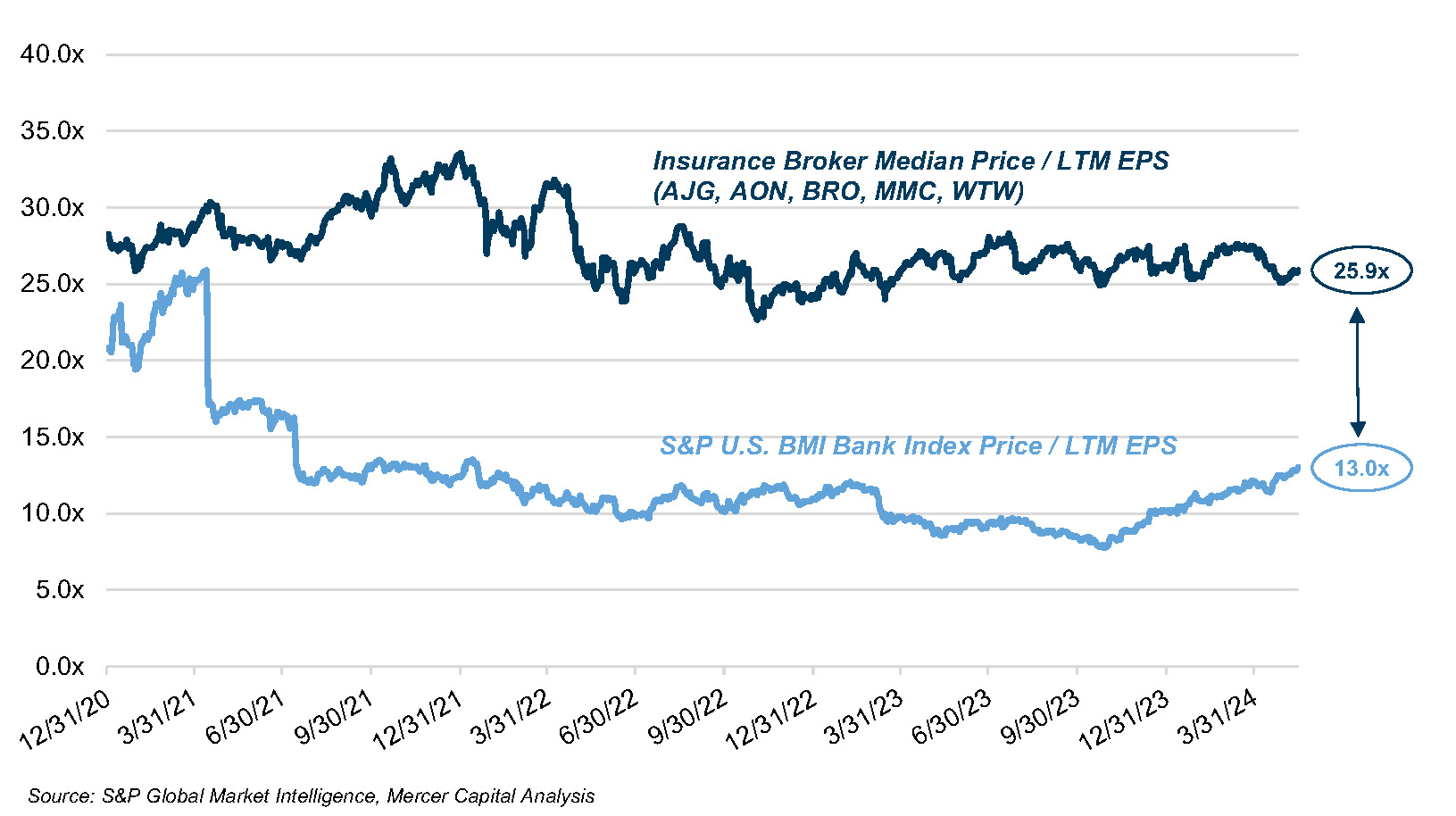
This arbitrage of earnings multiples has undoubtedly influenced many sellers of bank-owned agencies in recent years. As observed by S&P Global Market Intelligence, 2023 marked the first time in at least eight years that U.S. banks divested more insurance agencies than they acquired (see Exhibit 2).
Exhibit 2: Bank Divestitures and Acquisitions of Insurance Agencies
The strategic rationale behind the latest group of divestitures has been largely consistent. Capitalizing on the sale of an insurance subsidiary at a favorable valuation provides several benefits, potentially including:
- Capital redeployment from lower-yielding to higher-yielding securities;
- The ability to offset losses from bond portfolio repositioning with the gain on the insurance unit sale;
- Enhancements to capital ratios;
- Tangible book value per share accretion; and,
- Additional support and focus for the core banking business.
In certain circumstances, the driving force behind a transaction might be the strategic imperative of a particular acquirer (such as the desire to bolster presence in a geographic market or to double down on a particular line of business).
Exhibit 3: Revenue Multiples for Select Bank / Insurance Agency Divestitures Since 2022
Click here to expand the image above
Exhibit 4: Earnings and EBITDA Multiples for Select Bank / Insurance Agency Divestitures Since 2022
Click here to expand the image above
On Exhibit 3, we have summarized the revenue multiples and other metrics for select insurance agency divestitures since 2022. Six of the eleven agencies had insurance revenue of under $20 million. At the other end of the spectrum, Truist’s sale of its insurance division to private equity buyers Stone Point and CD&R is one of the largest insurance brokerage transactions of all time (and was achieved in 20% and 80% stages). Public acquirer Arthur J. Gallagher & Co. has been the most prolific bank agency acquirer, inking large deals for M&T Insurance, Eastern Insurance, and Cadence Insurance.
One interesting observation is that the price paid as a multiple of insurance revenue is only loosely correlated with size. The median revenue multiple for the group is 3.9x.
Exhibit 4 presents the earnings multiples (where available) for the same group of agency transactions. Obviously, not all buyers/sellers choose to disclose earnings multiples and not all of the bank sellers report segment-level financial statements for their insurance subsidiaries. Further, transactions in the insurance brokerage industry are often struck on the basis of pro forma earnings (or EBITDA) to the buyer.
It is likely that these buyers (most of whom are either strategic or private equity sponsored consolidators) would anticipate a modest amount of add-backs for reduced back-office expenses and other industry synergies. While there is greater dispersion in these observations, the median EBITDA and earnings multiples for the group are 15.8x and 28.3x, respectively.
So are bank acquisitions of insurance agencies a thing of the past now? Not necessarily. Hindsight is always 20/20. Perhaps banks should have pushed back against the private equity buyers over the last decade and been willing to bid higher on acquisitions. In retrospect, paying 8x or 10x or even 12x EBITDA for a small insurance agency doesn’t seem that crazy when the consolidated unit can now be monetized at 15x.
Often, the best determinant of total return in an M&A deal is entry price, and so if a bank has the ability to source proprietary off-market agencies or books of business through local connections, that strategy is still well worth considering.
What about banks that already have an insurance subsidiary? What steps should you take? Here are a few suggestions:
- Conduct a strategic evaluation of the agency in the context of the bank’s overall strategy. Does the agency fit into the long-term vision of the bank? Is the sum of the parts greater than the whole?
- What is the agency’s true earning power or valuation as a stand-alone entiy? Consider obtaining an independent valuation or Quality of Earnings study to analyze the financials, ask the difficult questions, and examine the business in the way that a potential acquirer would.
- If sale is a possibility, is the business actually ready for sale? Is the corporate structure clean or messy? Do you have a collection of third-party producer arrangements that need to be consolidated? Are there minority owners? How does the expense allocation and/or resource sharing between the bank and agency work?
- Do you have alignment between the agency and bank management? Are there separate boards? Intertwined management and/or ownership? Would a sale create potential issues of conflict or necessitate a fairness opinion?
Even if all the other boxes are checked, is selling the bank’s agency that took 20 years to build the right long-term move? Maybe. Is it shortsighted to sell off the golden goose agency in the name of “balance sheet repositioning”? Maybe not. Every situation and every transaction is unique. Clearly, the banking and insurance industries are at an interesting place right now – and if you are a participant in both then you have a few options to consider.
If you have questions about these topics or would like to discuss a situation in confidence, please contact a Mercer Capital professional.
Essential Financial Documents to Gather During Divorce – Part 4
Documents Needed to Perform Forensic Analysis
Prepared by Mercer Capital’s Family Law Services Team
Previously in this series, we discussed the importance of hiring an expert and the documents needed to prepare the marital balance sheet, analyze support and need in a Lifestyle Analysis (aka Pay & Need Analysis), and perform a business valuation.
This month, we conclude our series with the documents needed for other forensics services and valuation services. There are numerous types of forensics services with which a qualified financial expert can assist, though many of the documents utilized in these analyses are already captured in other divorce-related analyses.
In this post, we discuss documents for arithmetic determinations of separate vs. marital, active vs. passive, and asset tracing. The appraiser/financial expert does not render legal opinions, though, assists with quantifying complex financial issues, while being aware of statutory and case law in varying jurisdictions.
Separate vs. Marital
When equitably dividing the marital estate, assets and liabilities must first be identified/categorized then quantified. As with personal goodwill last month, the analysis does not always stop there as the total value of an asset may or may not be fully marital. The increase in value of a business owned and operated by a divorcing spouse is more complicated (as discussed below). However, in many jurisdictions, a retirement account balance that appreciates solely due to market forces is usually considered passive appreciation, unless, perhaps one spouse has a background in investing and is actively managing the account as part of his/her business activities.
If the appreciation of the date-of-marriage balance is deemed passive, the marital interest in an account can grow from $0 from marital contributions during the marriage and market growth/decline on said marital contributions. For example, say a spouse saves $25,000 towards retirement prior to marriage and continues to contribute post-nuptials with marital money. If the balance at divorce is $100,000, some portion of that may be marital (contributions during marriage plus growth of those contributions), while the original $25,000 plus any market gains on that initial balance during the marriage, may be separate, depending on state statutes.
To perform this analysis, we need:
- Monthly/quarterly/annual retirement account statements, sometimes dating back to date of marriage
- Paystubs and/or W-2s detailing contributions over time (if not shown on account statements)
The financial expert will also pull data from the market and maybe even industry indices. The math and methodology are straightforward, and it is likely that financial experts would come up with similar conclusions if each expert is given the same set of financial documents, use reasonable methodologies and both correctly understand how separate vs. marital works in the couple’s jurisdiction.
Active vs. Passive
For active vs. passive analyses of business appreciation, two valuations will usually be necessary: one valuation as of a current date, and one as of the date of marriage. In some jurisdictions, a third is necessary for the date of separation. If a valuation is not available as of the date of marriage, the appraiser can perform a retrospective appraisal. The financial expert should consult with the attorney on the matter to ensure they understand the active vs. passive precedent in the state in which he/she is providing services, as these may differ. The retrospective appraisal will require much if not all the same documentation as the current valuation, just backdated to the date of marriage.
We discussed the documents to obtain for valuation purposes in Part 3 of this series. Additional quantitative and qualitative data may need to be obtained for active vs passive analyses, including:
- Efforts of the divorcing spouse versus efforts of others (management, leadership, owners, employees)
- Efforts of third parties
- Relationships with vendors, customers, etc. (held by a divorcing spouse or other members of management team)
- Characteristics of the business at the various valuation dates (this may be already gathered in conjunction with the valuation process)
- Source of additional funding/capital, if applicable
The financial expert will also analyze changes in the industry, regulations, tax rates/law, and the general economy between the valuation dates.
Asset Tracing
Asset Tracing services can be performed in conjunction with analyses of separate vs. marital as well as investigative services for potential dissipation/waste claims. For the latter, before we pursue these analyses, there are typically two questions to consider.
- What is being investigated?
- How much time/effort/money may be required to investigate and corroborate the dissipation analysis?
- This can be a difficult answer for forensic professionals, as we may or may not yet have an understanding of scope, level of documentation involved, etc. In our experience, progress updates typically assist the process.
Key documents to “follow the money” in tracing exercises are monthly bank statements and credit card statements. This analysis can become complicated when there are numerous bank accounts, but money usually transfers in and out of a bank. Tracing cash that doesn’t make its way to a bank, whether personal or business-related, becomes a bit more difficult but the analysis can be handled. The documents requested will vary, but many such analyses will require relevant bank statements and general ledgers if a business is involved.
Conclusion
A financial expert can help focus the scope of a divorce case, saving time and money throughout the process, particularly if brought in early to the process with ample time to assist with the various stages of the case. We help engagements be as efficient as possible, hoping to reduce the need to update our analysis, which can drag out the process and lead to higher costs for clients. For more information or to discuss your matter with us, please don’t hesitate to contact us.
Essential Financial Documents to Gather During Divorce Series
The Noncompete Agreement Is Dead, Long Live the Noncompete Agreement
The FTC Wants to Ban Noncompete Agreements but They Will Likely Endure in Certain Circumstances
We don’t typically see news about noncompete agreements on the first page of the Wall Street Journal, much less above the fold. But on April 24, the FTC finalized a rule that effectively prohibits the enforcement of existing noncompete agreements in most cases and disallows them going forward. While the ruling wasn’t a complete surprise – the legality of noncompete agreements has been challenged in many states and the FTC has been discussing the topic for several months – its potential ramifications for intangible asset valuation and reporting are minimal, at least so far.
Essentially, the FTC has declared most existing noncompete agreements unenforceable. A few exceptions have been carved out for existing agreements, namely those with “senior executives.” Additionally, entities outside of FTC purview, such as nonprofit organizations, are entirely exempt from the rule. For the most part, however, the FTC would like most noncompete agreements to go the way of dodos and passenger pigeons.
The full rule is over 570 pages and can be viewed here. But to spare our readers that burden, here are a few key takeaways from our reading of the rule and its potential impact on financial statement reporting and valuation:
- Noncompete agreements have occupied a fuzzy legal status for several years. As a result, noncompete agreements are typically ascribed minimal value during a purchase price allocation exercise. This might be due to a lack of enforceability or the particular facts and circumstances of the subject industry or covered individual.
- With respect to a transaction, “[t]he final rule does not apply to non-competes entered into by a person pursuant to a bona fide sale of a business entity” or in the sale of a division or subsidiary of an entity. This describes a great many of the noncompetes we encounter for purchase price allocations. While a noncompete agreement that previously existed may become unenforceable under the FTC’s ruling, it appears that noncompete agreements arising in connection with a transaction would still be enforceable, and thus, may continue to have value. Interestingly, the transaction exception continues to make noncompete agreements relevant within the context of Section 280G compliance.
- Existing noncompete agreements are explicitly allowed to be enforceable for “senior executives.” The final rule defines the term “senior executive” as someone earning more than $151,164 who is in a “policy-making position.” The final rule does not permit new agreements with “senior executives,” but does preserve those already in effect (and, presumably, recorded as intangible assets in a firm’s financial statements).
- The FTC has permitted non-disclosure agreements (and estimates that over 95% of noncompete agreements already have NDAs). From a trade-secret perspective, the FTC clearly prefers NDAs to noncompete agreements. Likewise, non-solicitation agreements are still permitted, which may continue to give rise to a distinct intangible asset.
Within a day of the issuance of the final rule, the U.S. Chamber of Commerce and other business groups jointly filed a lawsuit against the FTC. Ordinarily, the final rule would become law after 120 days, but the actual implementation may be delayed as legal proceedings continue. At the current moment, the litigation continues the uncertainty surrounding noncompete agreements.
From a valuation perspective, eliminating the separate recognition of noncompete agreements would shift value from an identifiable, amortizable asset into goodwill. However, because noncompete agreements often comprise a relatively small allocation of total transaction value, the overall impact of this transfer of value may be minimal. Interestingly enough, a second-order impact of the elimination of noncompete agreements could be an increase in customer attrition rates used in the valuation of customer-related intangible assets. If customer accounts are more susceptible to competition and poaching, then the fair values ascribed to those assets might go down.
Mercer Capital has significant experience in the valuation of noncompete agreements for financial reporting and other purposes, such as Section 280G compliance. To discuss other ramifications of the FTC’s new rule on noncompete agreements or any other financial reporting valuation matter, please contact a Mercer Capital professional.
Now Could Be a Great Time for Bank Investors to Consider Estate Planning
It may be an opportune time for bank investors to consider estate planning opportunities. Rising inflation has been top of mind for business owners and bankers (and everyone for that matter) over the last few years. While inflation has decelerated from its peak, business owners, bankers, and investors are adjusting to the new higher for longer interest rate environment.
Higher inflation and interest rates have affected every business with few exceptions. All else equal, higher interest rates will negatively affect business value as higher discount rates are used to bring future cash flows to the present. In some industries though, inflation-driven increases in earnings or revenue growth expectations have offset (or even outweighed) the negative impact of higher interest rates.
However, not all industries have been immune to pressure from higher interest rates and inflation on the value of their shares. Banking is one of several industries that have underperformed broader market indices as investors remain skeptical of the “new normal” and impact of the rate environment on banks’ cost of funds and net interest margins.
As shown in the following tables, small and mid cap public bank stocks have underperformed broad market indices, and valuation multiples (as measured by P/E and P/TBV) remain below long-term historical averages.
While it remains uncertain when the interest rate easing cycle will begin, the easing cycle will likely also have divergent outcomes for different industries. At this point between cycles and with bank valuation multiples below long-term averages, it is important to consider the potential opportunity to favorably transfer business value to future generations.
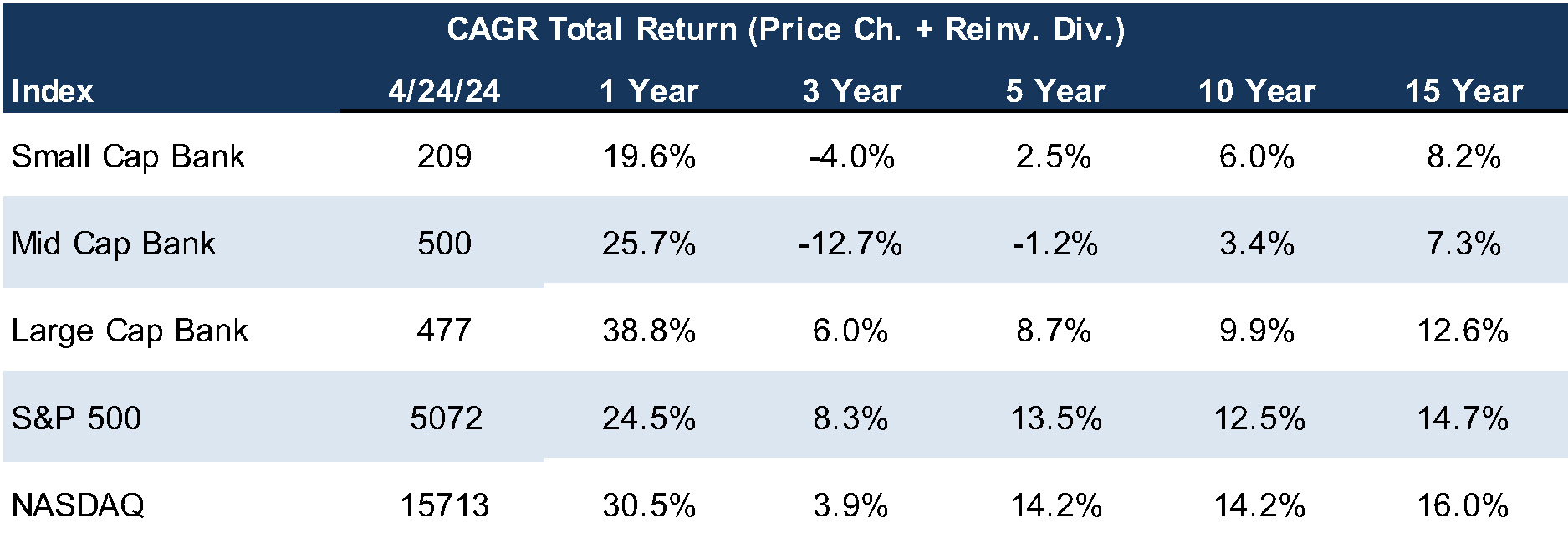

A second reason to consider estate planning transactions in the current environment is issues on the tax and policy front. The Tax Cuts and Jobs Act enacted in December 2017 doubled the basic exclusion amounts individuals could give away without paying estate taxes. The sunsetting of this provision on December 31, 2025 and the potential for lower exclusion amounts thereafter and higher estate taxes, makes considering transfers all the more important.
The combination of lower bank stock valuations combined with sunsetting favorable estate tax provisions make 2024 a worthwhile year for bank investors to consider estate planning strategies. Many strategies will require a current valuation of your bank, and our professionals are here to help.
What to Look for in a Quality of Earnings Provider
The cost of corporate M&A failures is high for both buyers and sellers.
- For buyers, overpaying for a target can hamper returns and crowd out other more attractive investment opportunities for years to come.
- Sellers only get one chance to sell their businesses. Failing to maximize proceeds represents a missed opportunity they can never get back.
These high stakes mean that thorough and high-quality due diligence is critical. A Quality of Earnings (or QofE) analysis is an essential component of transaction diligence for both buyers and sellers. Optimizing your transaction diligence requires assembling the right team.
In this article, we discuss four things buyers and sellers should look for when evaluating potential QofE providers.
1 . Transaction Experience
Don’t view your QofE analysis as a mere “check box” on your diligence list. A QofE report should provide genuine insight about the target before you reach the closing table. While a QofE analysis can, in some respects, feel like an audit, it is not one. Instead, it is a component of transaction diligence, so you should inquire about a potential provider’s transaction experience.
- Has the QofE provider represented buyers or sellers in transactions?
- Has the QofE provider advised buyers on M&A strategy?
- Has the QofE provider rendered fairness or solvency opinions?
2. Valuation Perspective
A quality of earnings analysis is not a valuation. However, every valuation includes an assessment of earnings quality. A QofE provider that brings a valuation perspective to the engagement is more likely to identify insights that matter to the proposed transaction price (i.e., valuation). Because of the close connection between QofE analysis and valuation, you should inquire as to a potential provider’s valuation perspective.
- Does the QofE provider have an active valuation practice?
- Do any of the QofE provider’s team members hold recognized valuation credentials?
- Do the members of the QofE provider’s team undertake continuing professional education
in valuation topics?
3. Technical Expertise
A quality of earnings analysis requires attention to detail, a thorough understanding of generally accepted accounting principles, and familiarity with the practical elements of accounting practice. Certified public accountants with audit experience are likely to possess each of these attributes.
- Does the QofE provider’s team include one or more experienced CPAs?
- Does the QofE provider’s team include members with audit or industry experience?
4. A Deep Bench
Transactions don’t wait. When it is time to move on a deal, you can’t waste time waiting for your QofE provider to catch up. When evaluating QofE service providers, you should inquire about the depth of resources they can bring to your assignment.
- Does the QofE provider have multiple engagement leaders capable of overseeing your
engagement? - Does the QofE provider have a pool of qualified staff capable of executing on the engagement on your timetable?
Conclusion
Successful buyers and sellers take Quality of Earnings analyses seriously. This requires taking care to select a QofE provider that can be a valuable member of your transaction diligence team. The best QofE providers generate relevant insights before you close your transaction – those insights are most likely to come from a team with a broad and deep technical skill set, transactional experience, and a valuation perspective.
WHITEPAPER
Quality of Earnings Analysis
For buyers and sellers, the stakes in a transaction are high. A QofE report is an essential step in getting the transaction right.
Essential Financial Documents to Gather During Divorce – Part 3
Documents Needed to Perform a Business Valuation
Prepared by Mercer Capital’s Family Law Services Team
In Parts 1 and 2 of this series, we discussed the importance of hiring an expert and the documents needed to prepare the marital balance sheet and analyzing support and need in a Lifestyle Analysis.
In this piece, we discuss the documents needed for performing a business valuation, the core competency of Mercer Capital.
There are many unique considerations and complexities to business valuation in divorce, often requiring more documentation and analyses. This includes personal goodwill, owner/operator compensation for valuation and income division purposes, formula clauses in Buy-Sell Agreements, and active vs passive, among others.
Documents for Business Valuation
As appraisers, we provide business valuations for divorce as well as many other purposes. Regardless of the industry, there are certain documents we request in every engagement:
- 5 years of financial statements (balance sheet, income statement, etc.)
- 5 years of business tax returns
- Budget/forecast/projections
- Compensation of owners and/or key management
- Corporate documents (operating/shareholder agreement(s), etc.)
- Recent valuations of the business or its underlying real estate
- List of top customers or relationships and revenue levels
- Key suppliers and any contractual relationships
- Available information on competition and/or industry
- Any documents provided to/received from a lending institution (bank) to receive financing
- Detail regarding recent transactions within the stock of the company
- Capitalization table (detailing ownership interests)
- Distribution policy
- Shareholder communications/Board minutes
Sometimes some of these documents/items do not exist at the subject Company, which will not necessarily prevent us from performing our work, but the more information we receive the better.
When valuing businesses, or really any stream of cash flows, valuation comes down to three variables: expected cash flow, risk, and growth. All else equal, investors want larger cash flows, that are growing faster, and that are less risky than alternative streams of cash flows. Financial documents show historical earnings and trends, which serve as a basis for expected future cash flows. Other information requested like top customers, suppliers, and competition show both capacity for growth and risks associated with the earnings the company has recently generated. A business valuation involves both qualitative and quantitative information and analyses.
Personal vs. Enterprise Goodwill
In divorce, there are additional considerations when valuing a business. A common battleground for experts is personal goodwill, which is not a divisible asset in divorce in many states. For example, if a business is worth $5 million, but it is determined that $3 million of the value is attributable to personal goodwill, the value of the business for marital balance sheet purposes might be $2 million.
There is no one-size-fits-all methodology or approach to allocating personal vs. enterprise goodwill. It will depend on the industry, history of the company, and relative contributions of the divorcing party as well as contributions of all other employees, among other factors. From a theoretical perspective, personal goodwill should show the difference in value of the business with and without the contributions from the divorcing party. Documents to help determine personal goodwill may include:
- Revenue generated by provider (what % of revenue is attributable to the divorcing spouse),
- List of roles/responsibilities of the divorcing spouse, among others.
The availability of documents will vary greatly. These complex analyses can be both a quantitative and qualitative analysis, and it will depend on the facts and circumstances what documents will be relevant.
Active vs. Passive
Like personal vs enterprise goodwill, an active vs passive analysis determines whether the appreciation of an asset or investment during a marriage is considered marital property. States differ in their treatment, and this analysis may be necessary for a business owned by a divorcing party prior to the marriage, which has appreciated during the marriage. However, it can also be necessary on investments in passively held retirement accounts. We will delve more into this in Part 4 regarding documents needed based on the nature of the investment.
Owner Compensation
In all business valuations, an assessment of the reasonableness of management compensation needs to be considered relative to market rates. It is common for business owners to not pay themselves exactly in line with market rates, or perhaps the owner compensation structure includes base rates and profit sharing. We see compensation structures in many different forms and fashions, and above/below market comp is not necessarily nefarious.
In the end, the money ends up in the owner/operator’s pocket, whether as W-2 earnings or distributions from company profits. In business valuation, particularly in divorce, it is more important to make a judgment on how much of the profits should be allocated to the owner’s labor (wages) and how much to their investment in the business (return on investment). In divorce, the business owner’s market wages may be utilized in determining alimony whereas the return on the investment in the business is capitalized into the present value of the business, which is placed on the marital balance sheet.
We consult available industry benchmarks to help determine reasonable compensation, but information about compensation for other key members of management and available industry-specific data is helpful in making these determinations.
Impact of Formula Clauses in Company Agreements on Business Valuations in Divorce
It is important to consider the purpose of the valuation, as this can influence the valuation conclusion. For example, some Buy-Sell Agreements provide for how a business is to be valued upon the death of a shareholder. However, this may not be relevant to the valuation in a divorce context for a few reasons:
- If a formula clause is included in a Buy-Sell prescribing how the company will be valued due to a “Triggering Event,” but divorce is not listed as one of these events, then it may not be relevant to the valuation during a marital dissolution.
- Even if divorce is listed as a Triggering Event, if the non-business spouse is not a party to and therefore does not sign the agreement, they are not necessarily bound to being bought out based on terms in a Buy-Sell or Operating Agreement.
- The Standard of Value for divorce purposes is typically Fair Market Value.
Conclusion
A financial expert can help focus the scope of a divorce case, saving time and money throughout the process, particularly if brought in early to the process with ample time to assist with the various stages of the case. We help engagements be as efficient as possible, hoping to reduce the need to update our analysis, which can drag out the process and lead to higher costs for clients.
For more information or to discuss your matter with us, please don’t hesitate to contact us.
Essential Financial Documents to Gather During Divorce Series
2024: Five Trends to Watch in the Medical Device Industry
Medical Devices Overview
The medical device manufacturing industry produces equipment designed to diagnose and treat patients within global healthcare systems. Medical devices range from simple tongue depressors and bandages to complex programmable pacemakers and sophisticated imaging systems. Major product categories include surgical implants and instruments, medical supplies, electro-medical equipment, in-vitro diagnostic equipment and reagents, irradiation apparatuses, and dental goods.
The following outlines five structural factors and trends that influence demand and supply of medical devices and related procedures.
1. Demographics
The aging population, driven by declining fertility rates and increasing life expectancy, represents a major demand driver for medical devices. The U.S. elderly population (persons aged 65 and above) totaled 60 million in 2023 (18% of the population). The U.S. Census Bureau estimates that the elderly will number 92.7 million by 2065, representing more than 25% of the total population.
U.S. Population Distribution by Age Group

The elderly account for nearly one third of total. Personal healthcare spending for the population segment was approximately $22,000 per person in 2020, 5.5 times the spending per child (about $4,000) and more than double the spending per working-age person (about $9,000).
U.S. Population Distribution by Age
U.S. Healthcare Expenditure by Age
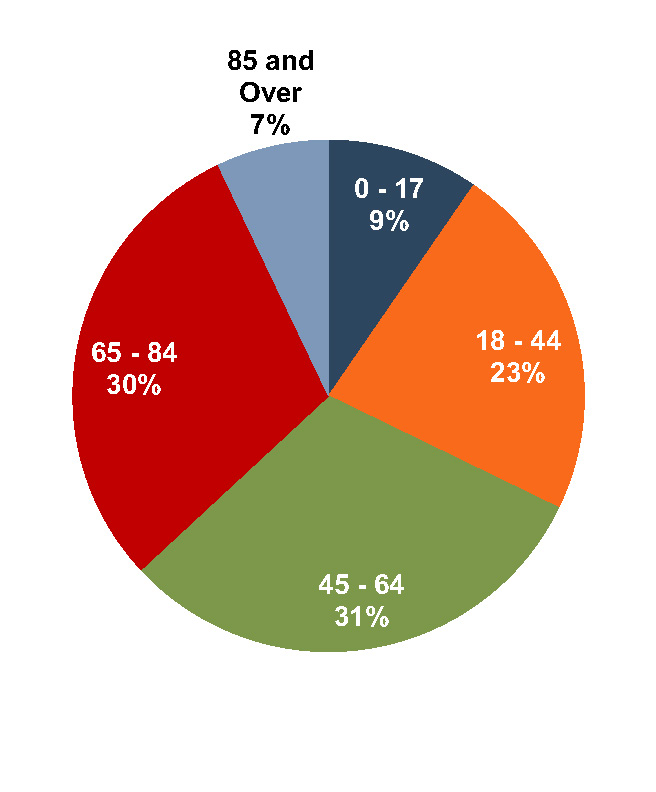
Source: U.S. Census Bureau, Centers for Medicare and Medicaid Services, Office of the Actuary, National Health Statistics Group
According to United Nations projections, the global elderly population will rise from approximately 808 million (10% of world population) in 2022 to 2.0 billion (19.4% of world population) in 2065. Europe’s elderly made up 20% of the total population in 2022, and the proportion is projected to reach 31% by 2065, making it the world’s oldest region. Latin American and the Caribbean is currently one of the youngest regions in the world, with its elderly at 9% of the total population in 2022, but this region is expected to undergo drastic transformations over the next several decades, with the elderly population expected to expand to 25% of the total population by 2065. North America has an above-average elderly population as of 2022 (17%) and is projected to expand to 27% by 2065.
World Population 65 and Over (% of Total)
Click here to expand the image above
2. Healthcare Spending and the Legislative Landscape in the U.S.
Demographic shifts underlie the expected growth in total U.S. healthcare expenditure from $4.4 trillion in 2022 to $7.2 trillion in 2031, an average annual growth rate of 5.5%. This projected average annual growth rate is slightly higher than the observed rate of 5.1% between 2013 and 2021, suggesting some acceleration in expected spending. Projected growth in annual spending for Medicare (7.5%) and Medicaid (5.0%) is expected to contribute substantially to the increase in national health expenditure over the coming decade. Growth in national healthcare spending, after significant growth in 2020 of 10.2%, slowed to 2.7% in 2021. Healthcare spending as a percentage of GDP is expected to increase from 18.3% in 2021 to 19.6% by 2031.
Since inception, Medicare has accounted for an increasing proportion of total U.S. healthcare expenditures. Medicare currently provides healthcare benefits for an estimated 65 million elderly and disabled people, constituting approximately 10% of the federal budget in 2021. Spending growth is expected to average 7.8% from 2025 to 2031. The program represents the largest portion of total healthcare costs, constituting 21% of total health spending in 2021 and 10% of the federal budget. Medicare accounts for 26% of spending on hospital care, 26% of physician and clinical services, and 32% of retail prescription drugs sales.
U.S. Healthcare Consumption Payor Mix and as % of GDP
Average Spending Growth Rates, Medicare and Private Health Insurance

Due to the growing influence of Medicare in aggregate healthcare consumption, legislative developments can have a potentially outsized effect on the demand and pricing for medical products and services. Medicare spending totaled $944.3 billion in 2022 and is expected to reach $1.8 trillion by 2031.
The Inflation Reduction Act (“IRA”) was signed into law on August 16, 2022 by the Biden administration. Among other items, the IRA aims to lower prescription drug costs and improve access to prescription drugs for Medicare enrollees. Two healthcare spending-related items in the IRA include out-of-pocket caps for insulin products (capped at $35 for each monthly subscription under Part D and Part B) and a $2,000 out-of-pocket annual spending cap for drugs under Medicare Part D. These provisions could have significant effects on the growth rates for out-of-pocket spending for prescription drugs, which are projected to decline by 5.9% and 4.2% in 2024 and 2025, respectively.
3. Third-Party Coverage and Reimbursement
The primary customers of medical device companies are physicians (and/or product approval committees at their hospitals), who select the appropriate equipment for consumers (patients). In most developed economies, the consumers themselves are one step (or more) removed from interactions with manufacturers, and, therefore, pricing of medical devices. Device manufacturers ultimately receive payments from insurers, who usually reimburse healthcare providers for routine procedures (rather than for specific components like the devices used). Accordingly, medical device purchasing decisions tend to be largely disconnected from price.
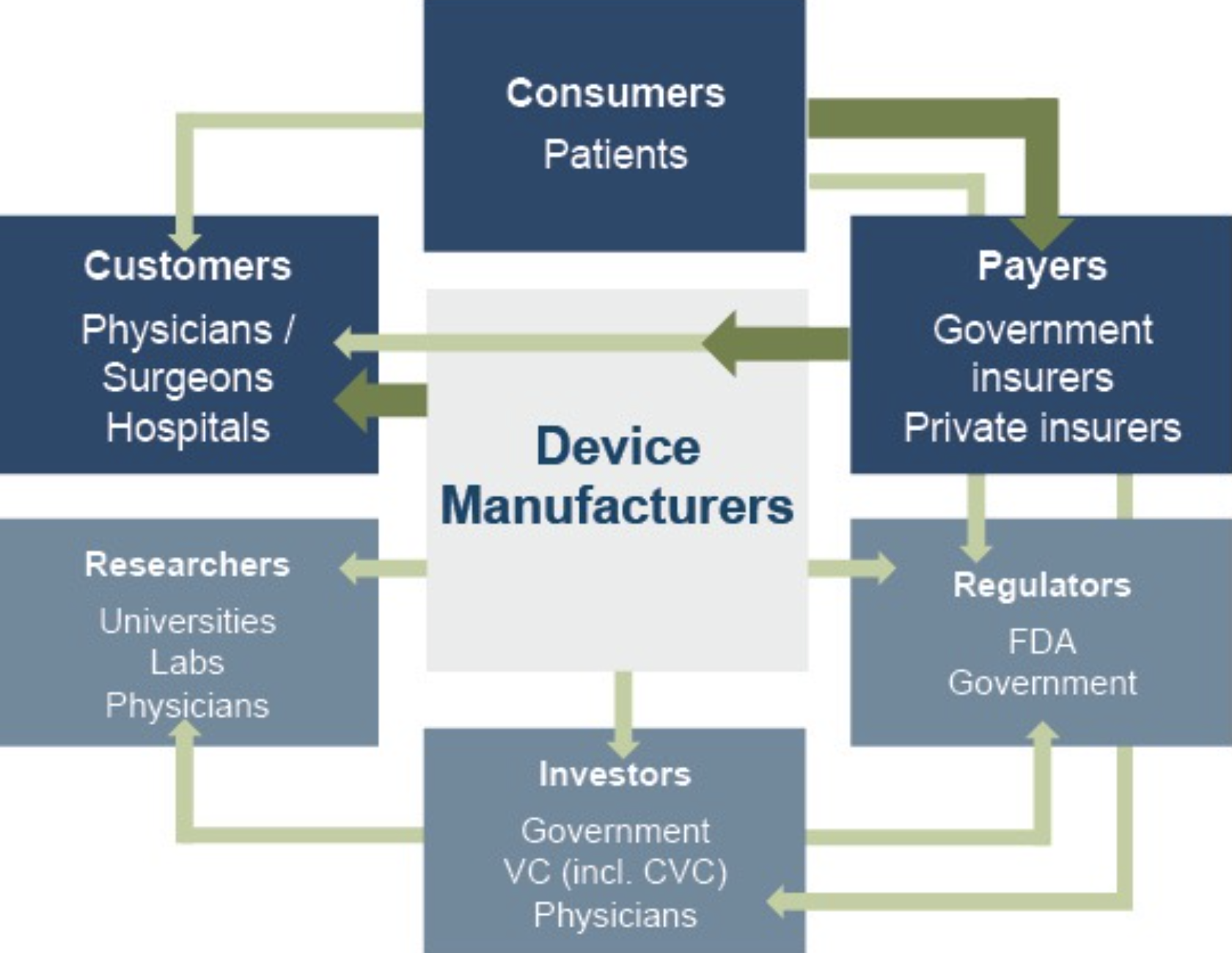
Third-party payors (both private and government programs) are keen to reevaluate their payment policies to constrain rising healthcare costs. Hospitals are the largest market for medical devices. Lower reimbursement growth will likely persuade hospitals to scrutinize medical purchases by adopting 1) higher standards to evaluate the benefits of new procedures and devices, and 2) a more disciplined price bargaining stance.
The transition of the healthcare delivery paradigm from fee-for-service (FFS) to value models is expected to lead to fewer hospital admissions and procedures, given the focus on cost-cutting and efficiency. In 2015, the Department of Health and Human Services (HHS) announced goals to have 85% and 90% of all Medicare payments tied to quality or value by 2016 and 2018, respectively, and 30% and 50% of total Medicare payments tied to alternative payment models (APM) by the end of 2016 and 2018, respectively. A report issued by the Health Care Payment Learning & Action Network (LAN), a public-private partnership launched in March 2015 by HHS, found that 48.9% of (traditional) Medicare payments were tied to Category 3 and 4 APMs in 2022, compared to 40% in 2021 and 35.8% in 2018.
In 2020, CMS released guidance for states on how to advance value-based care across their healthcare systems, emphasizing Medicaid populations, and to share pathways for adoption of such approaches. CMS states that value-based care advances health equity by putting focus on health outcomes of every person, encouraging health providers to screen for social needs, requiring health professionals to monitor and track outcomes across populations, and engaging with providers who have historically worked in underserved communities. Ultimately, lower reimbursement rates and reduced procedure volume will likely limit pricing gains for medical devices and equipment.
The medical device industry faces similar reimbursement issues globally, as the EU and other jurisdictions face similar increasing healthcare costs. A number of countries have instituted price ceilings on certain medical procedures, which could deflate the reimbursement rates of third-party payors, forcing down product prices. Industry participants are required to report manufacturing costs, and medical device reimbursement rates are set potentially below those figures in certain major markets like Germany, France, Japan, Taiwan, Korea, China, and Brazil. Whether third-party payors consider certain devices medically reasonable or necessary for operations presents a hurdle that device makers and manufacturers must overcome in bringing their devices to market.
4. Competitive Factors and Regulatory Regime
Historically, much of the growth of medical technology companies has been predicated on continual product innovations that make devices easier for doctors to use and improve health outcomes for the patients. Successful product development usually requires significant R&D outlays and a measure of luck. If viable, new devices can elevate average selling prices, market penetration, and market share.
Government regulations curb competition in two ways to foster an environment where firms may realize an acceptable level of returns on their R&D investments. First, firms that are first to the market with a new product can benefit from patents and intellectual property protection giving them a competitive advantage for a finite period. Second, regulations govern medical device design and development, preclinical and clinical testing, premarket clearance or approval, registration and listing, manufacturing, labeling, storage, advertising and promotions, sales and distribution, export and import, and post market surveillance.
Regulatory Overview in the U.S.
In the U.S., the FDA generally oversees the implementation of the second set of regulations. Some relatively simple devices deemed to pose low risk are exempt from the FDA’s clearance requirement and can be marketed in the U.S. without prior authorization. For the remaining devices, commercial distribution requires marketing authorization from the FDA, which comes in primarily two flavors.
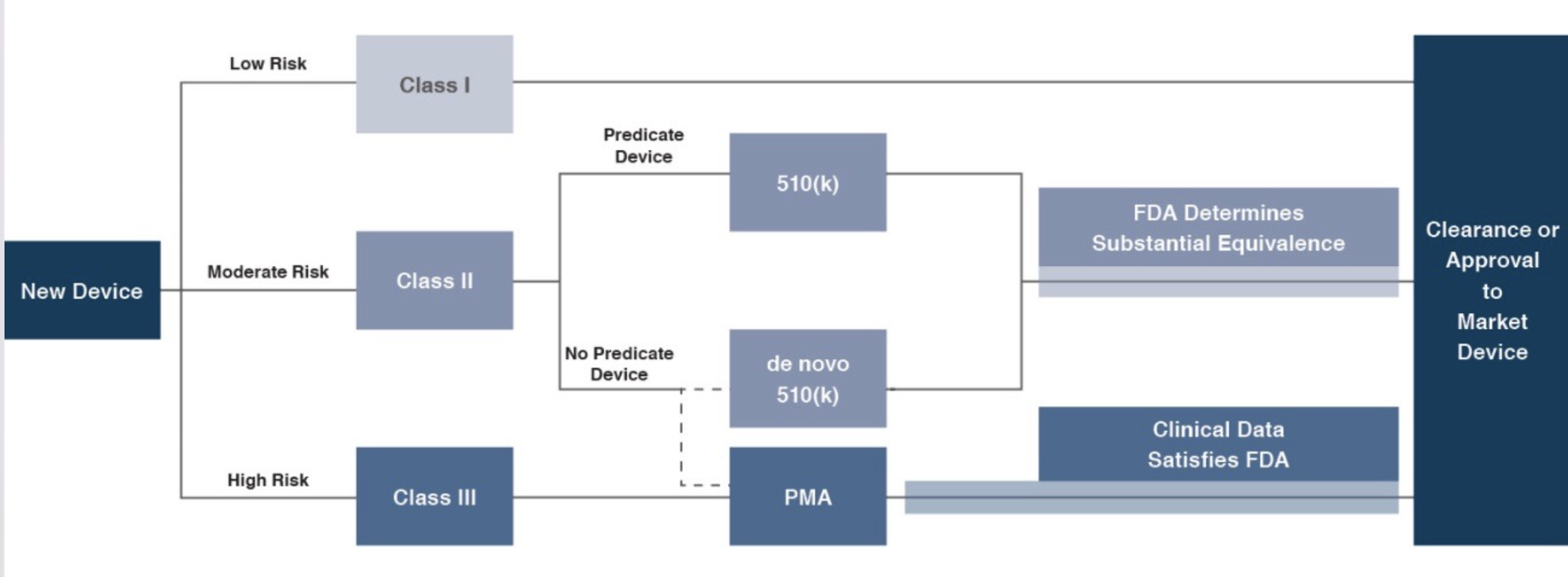
- The premarket notification (“510(k) clearance”) process requires the manufacturer to demonstrate that a device is “substantially equivalent” to an existing device (“predicate device”) that is legally marketed in the U.S. The 510(k) clearance process may occasionally require clinical data and generally takes between 90 days and one year for completion. In November 2018, the FDA announced plans to change elements of the 510(k) clearance process. Specifically, the FDA plan includes measures to encourage device manufacturers to use predicate devices that have been on the market for no more than 10 years. In early 2019, the FDA announced an alternative 510(k) program to allow medical devices an easier approval process for manufacturers of certain “well-understood device types” to demonstrate substantial equivalence through objective safety and performance criteria. In February 2020, the FDA launched its voluntary pilot program: electronic Submission Template and Resource (eSTAR) as an interactive submission template that may be used by the medical device submitters to prepare certain pre-market submissions for a device. Starting in October 2023, all 510(k) submissions were required to be submitted using eSTAR unless exempted.
- The premarket approval (“PMA”) process is more stringent, time-consuming, and expensive. A PMA application must be supported by valid scientific evidence, which typically entails collection of extensive technical, preclinical, clinical, and manufacturing data. Once the PMA is submitted and found to be complete, the FDA begins an in-depth review, which is required by statute to take no longer than 180 days. However, the process typically takes significantly longer and may require several years to complete.
Pursuant to the Medical Device User Fee Modernization Act (MDUFA), the FDA collects user fees for the review of devices for marketing clearance or approval. The current iteration of the Medical Device User Fee Act (MDUFA V) came into effect in October 2022. Under MDUFA V, the FDA is authorized to collect $1.8 billion in user fee revenue for the five-year cycle, an increase from the approximately $1 billion in user fees under MDUFA IV, between 2017 and 2022. A significant change from MDUFA IV to MDUFA V relates to performance goals for De Novo Classification requests (requests for novel medical devices for which general controls alone provide reasonable assurance of safety and effectiveness for the intended use). There has also been updated PMA guidance, with the FDA conducting substantive reviews within 90 calendar days for all original PMAs, panel-track supplements, and 180-day supplements.
Regulatory Overview Outside the U.S.
The European Union (EU), along with countries such as Japan, Canada, and Australia all operate strict regulatory regimes similar to that of the FDA, and international consensus is moving towards more stringent regulations. Stricter regulations for new devices may slow release dates and may negatively affect companies within the industry.
Medical device manufacturers face a single regulatory body across the European Union: Regulation (EU 2017/745), also known as the European Union Medical Device Regulation (EU MDR). The regulation was published in 2017, replacing the medical device directives regulation that was in place since the 1990s. The requirements of the MDR became applicable to all medical devices sold in the EU as of May 26, 2021. The EU is the second largest market for medical devices in the world with approximately €150 billion in sales in 2022, only behind the United States. The EU MDR has introduced stricter requirements for medical device manufacturers, including increased clinical evidence and post-market surveillance. Consequently, there is an increased risk for longer approval processes and delays in manufacturing of these devices.
5. Emerging Global Markets
Emerging economies are claiming a growing share of global healthcare consumption, including medical devices and related procedures, owing to relative economic prosperity, growing medical awareness, and increasing (and increasingly aging) populations. According to the WHO, middle income countries, such as China, Turkey, and Peru, among others, are rapidly converging towards outsized levels of spending as their income scales. When countries grow richer, the demand for health care increases along with people’s expectation for government-financed healthcare. Upper-middle income countries accounted for 16.6% of total global healthcare spending in 2021, up from 8.2% in 2000.
As global health expenditure continues to increase, sales to countries outside the U.S. represent a potential avenue for growth for domestic medical device companies. According to the World Bank, all regions (except Sub-Saharan Africa and South Asia) have seen an increase in healthcare spending as a percentage of total output over the last two decades.
World Health Expenditure as a % of GDP
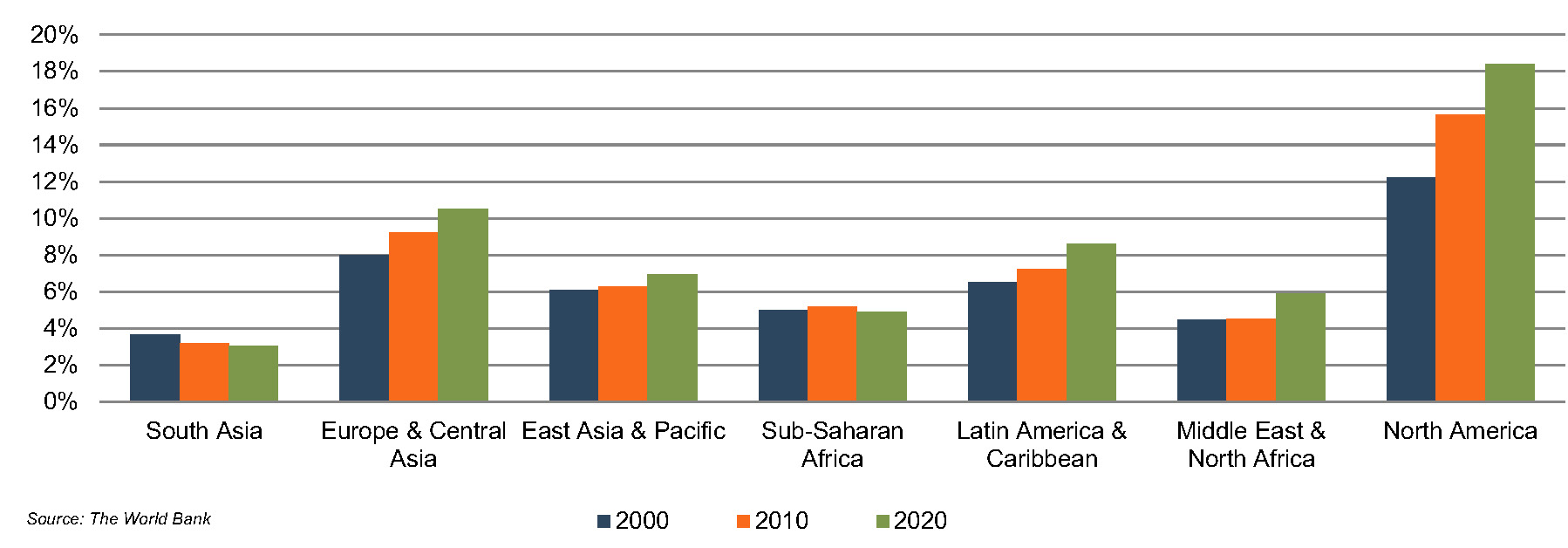
Global medical device sales are estimated to increase 5.9% annually from 2023 to 2030, reaching nearly $800 billion according to data from Fortune Business Insights. While the Americas are projected to remain the world’s largest medical device market, the Asia Pacific market is expected to expand at a relatively quicker pace over the next several years.
Summary
Demographic shifts underlie the long-term market opportunity for medical device manufacturers. While efforts to control costs on the part of the government insurer in the U.S. may limit future pricing growth for incumbent products, a growing global market provides domestic device manufacturers with an opportunity to broaden and diversify their geographic revenue base. Developing new products and procedures is risky and usually more resource intensive compared to some other growth sectors of the economy. However, barriers to entry in the form of existing regulations provide a measure of relief from competition, especially for newly developed products.
Post-Script – 2024 Outlook
The medical device industry looked to have put the effects of COVID-19 behind by 2023. A large number of elective procedures were deferred in the early part of the pandemic and a measure of catch-up in procedure volumes was reported in subsequent periods. Back to focusing on the longer-term demographic and other trends?
Well, maybe not quite so fast. It was always likely that the pandemic-induced disruptions would linger just a bit longer, creating some uncertainty around consumers’ needs and preferences. But the industry awakened to a different type of potential disruption in mid-2023. Would GLP-1 drugs alter long-term demographic trends by reducing massive obesity rates? And would the industry face widespread lower demand for bariatric surgery devices, glucose monitors, cardiovascular devices, orthopedic implants and other equiptment? A mid-year swoon in medtech stock prices was attributed, at least by some, to the wonder drugs. As 2023 came to a close, however, many appear to have reversed course from that early response. We may or may not get more clarity on the longer-term effects of these treatments in 2024 but, surely, they will also bring opportunities to go along with potential challenges for device makers.
Taking a broader view, some trends from recent periods will likely persist in 2024. Companies will continue to focus on profitability and profitable growth in a (relatively) higher-interest rate environment. Some observers suggest that an expected but measured decline in rates over 2024 (if it materializes) may not do much for medtech stock prices, further underscoring the need to shore up margins. On the flip side, since the period of rapid interest rate increases appears to be behind us, transaction volume should pick up from the low levels of the past two years. Finally, innovation, as always, will continue to be part of the conversation as novel treatments that serve unmet needs will help to unlock new markets.
2024 Outlook reading list:
- What To Expect From Medtech In 2024 (McKinsey & Company)
- 5 Medtech Trends To Watch In 2024 (MedtechDive)
- 2024 Outlook For Life Sciences: GenAI, Drug Prices, Economy Likely To Influence Strategy (Deloitte)
NYCB Incurs Heavy Dilution in Its $1.0 Billion Capital Raise
The other significant industry news from the first quarter was the $1.05 billion equity investment in New York Community Bank (NYSE: NYCB) by an investor group led by former Secretary of the Treasury Steve Mnuchin. The investment was necessary to boost loss absorbing capital and to shore up confidence to stem a possible deposit run after its share price collapsed during February following a surprise fourth quarter loss that was later revised higher for a $2.4 billion goodwill write-off.
The initially reported 4Q23 loss of $252 million was not catastrophic, especially considering the company reported net income of $2.4 billion excluding the goodwill write-off as a result of the bargain gain from the purchase of the failed Signature Bank; however, the fourth quarter loss that arose from a $538 million provision for loan losses highlighted investor concerns about NYCB’s sizable exposure to NYC rent-controlled apartments and offices.
The figure on the right presents our proforma analysis of the transaction and its impact on the consolidated company (NYCB), the parent company in which the group invested, and wholly owned Flagstar Bank, N.A. The adage that capital is exorbitantly expensive if available at all when it must be raised comes to mind here with NYCB.
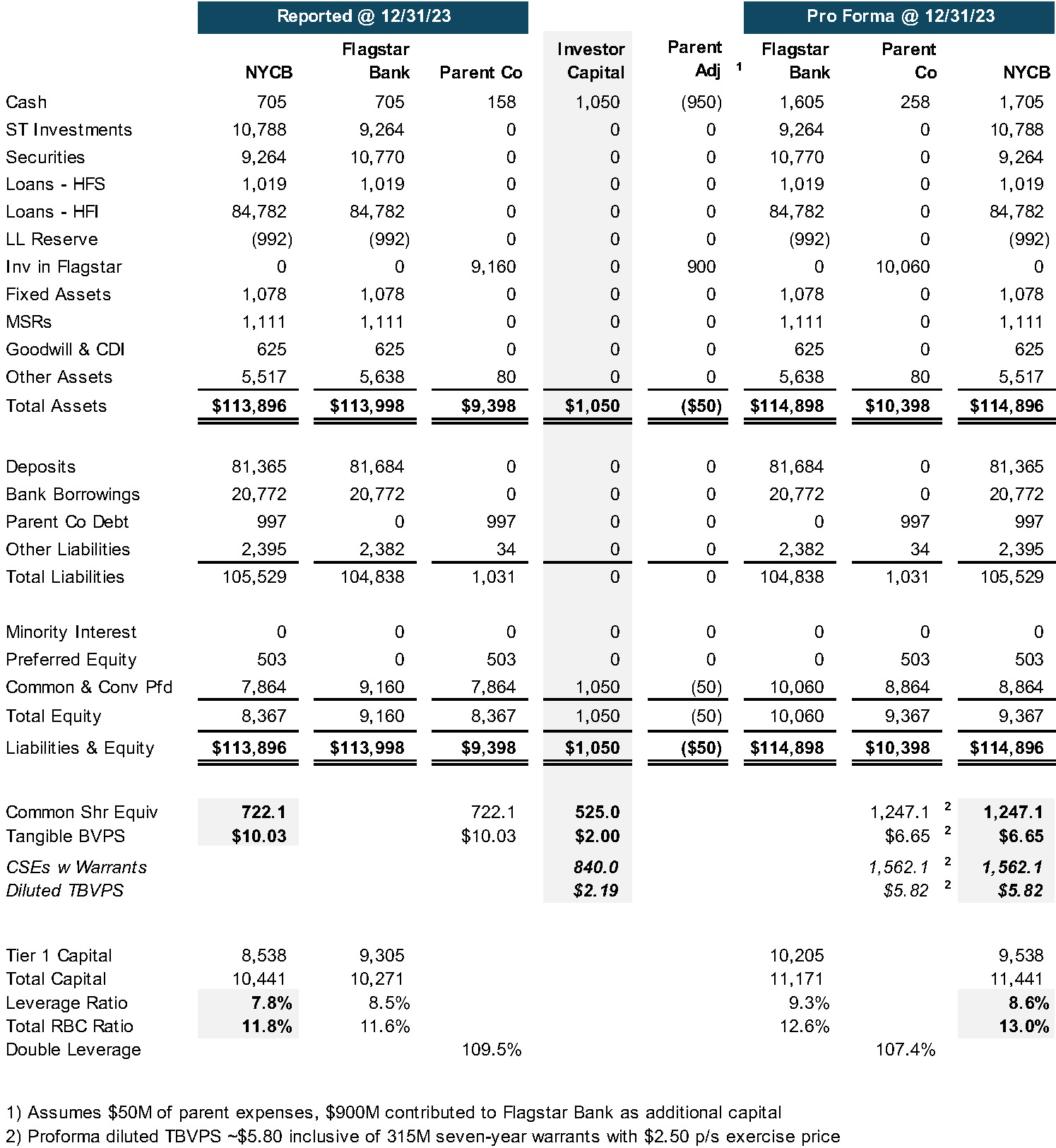
Source: Mercer Capital, NYCB SEC filings, and S&P Global Market Intelligence
We note the following:
- The investor group paid $1.05 billion for 525 million common share equivalents consisting of 59.8 million common shares for $2.00 per share and $930 million of Series B and C preferred stock with a 13% dividend that is convertible into 465 million common shares at $2.00 per share.
- Tangible book value per share (“TBVPS”) declined by about one-third from $10.03 per share as of year-end 2023 to $6.65 per share on a proforma basis.
- Inclusive of 315 million seven-year warrants with a $2.50 per share strike price, diluted proforma TBVPS is ~$5.80 per share.
- The 525 million common shares represent ~40% of the 1.25 billion proforma shares while dilution to existing shareholders exceeds 50% inclusive of the warrants.
- The capital injection boosted the Company’s consolidated leverage ratio by ~80bps to 8.6% and total risk-based capital ratio by ~120bps to 13.0%.
- NYCB will generate ~$1.4 billion of pretax, pre-provision operating income in 2024 and 2025 based upon consensus analyst estimates that will supplement the new capital to absorb loan losses.
- Given NYCB’s shares are trading around 50% to 60% of proforma TBVPS, investors are questioning the magnitude of loan losses to be recognized; whether more capital will be required; and long-term earning power.
Our additional thoughts on the transaction can be found HERE, and a link to NYCB’s investor deck announcing the transaction can be found HERE.
If we can assist your board with a capital raise or other significant transaction, please call us.
Capital One Financial Corporation to Acquire Discover Financial Services
The four major credit card networks are American Express, Discover, Mastercard, and Visa. In 2023, Discover had only 2.1% of the total market share in the U.S. based on the value of transactions, compared to Visa’s 61.1% market share and Mastercard’s 25.4% market share.1 Prior to its acquisition of Discover, Capital One partnered with both Visa and Mastercard for issuing their credit cards. So, why would Capital One pay $35.3 billion to acquire Discover’s 2.1% market share?
Discover Financial Services operates as both a credit card issuer and credit card network. By owning its own credit card network, Discover is not partnered with any payment processors (Visa, Mastercard, etc.) and avoids “swipe fees” that payment processors collect. Therefore, one of Capital One’s primary objectives in acquiring Discover is to move its credit and debit cards onto Discover’s network over time and reduce its purchase volume on the Visa and Mastercard networks.
The two companies entered into a definitive agreement on February 19, 2024, in which Capital One Financial Corporation agreed to acquire Discover Financial Services in an all-stock transaction valued at $35.3 billion. The deal represents a 26.6% premium to Discover’s closing price of $110.49 (2/26/24) as Discover shareholders will receive 1.0192 Capital One shares for each Discover share. More details on the transaction as well as the companies’ financials as of fiscal 2023 are displayed on the right.
Summary of Transaction Analysis

Financial Comparison
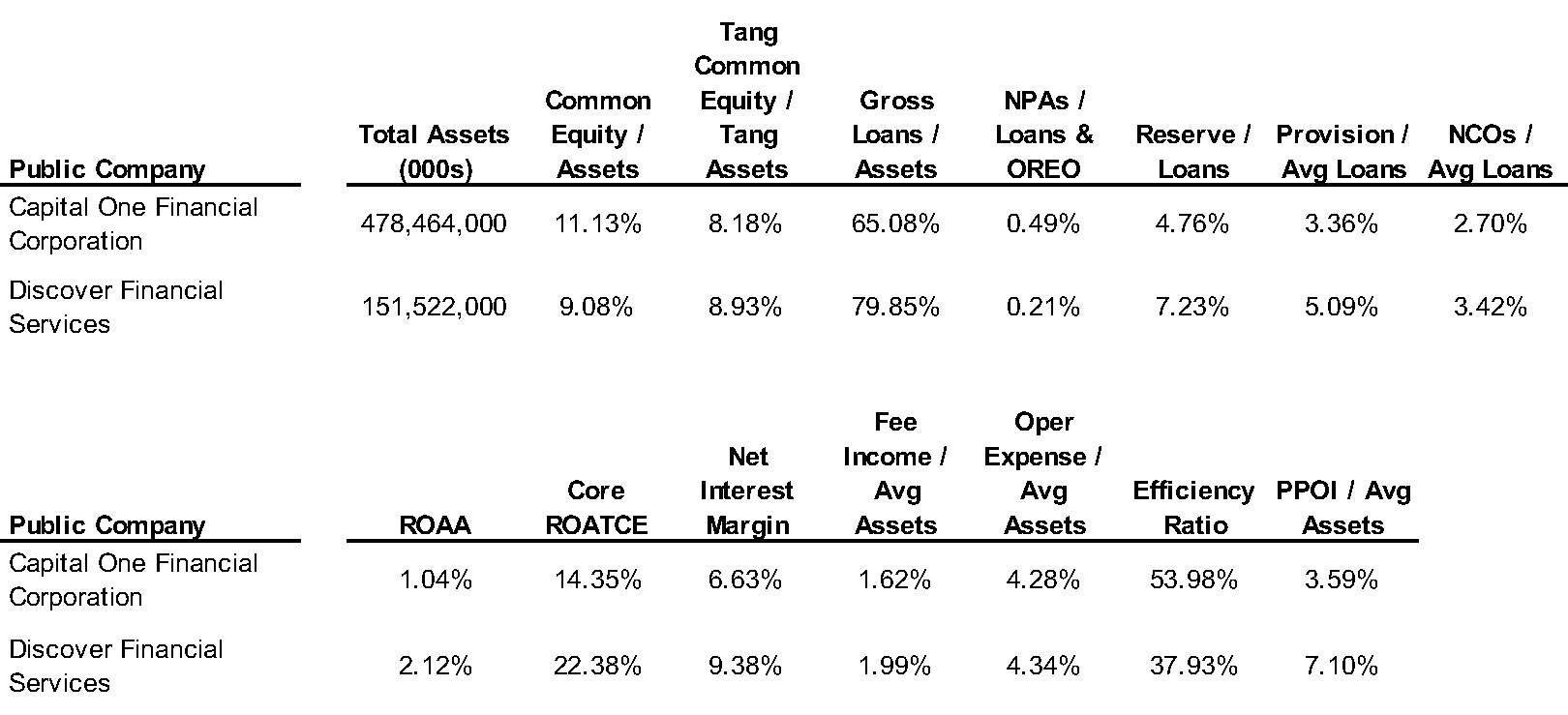
Preparing for the Future
As technology continues to advance, both traditional, tech-heavy banks and
Fintech companies have increased competition in the global payments industry. If the acquisition is approved, Capital One will surpass JPMorgan as the largest credit card company based on loan volume and become the third largest company based on purchase volume. With increased volume and market share, Capital One would be better prepared to compete against these other banks and Fintech companies. Richard Fairbank, the CEO of Capital One, strives to deal directly with merchants by owning his own payments network. This rare asset allows Capital One to create a closed loop between consumers and merchants, which better positions the company to deal with increasing threats from buy-now, pay-later companies (Affirm, Afterpay, Klarna, etc.).
Both Capital One and Discover customers may have a lot to look forward to in the future should the deal be approved. Capital One intends to move 25 million cardholders onto the Discover network by 2027 and offer more attractive rewards for both debit and credit cardholders. The proposed merger would expand both issuers’ physical presence, and Discover customers would gain access to physical bank locations. Capital One will also leverage its international presence to increase accessibility and convenience for Discover cardholders on an international scale. In terms of credit and debit rewards, the increased competition in the industry is expected to drive companies to bolster their rewards program to seem more attractive to consumers.
Regulatory Hurdles
The proposed deal between Capital One and Discover is expected to close by the end of 2024 or the beginning of 2025. However, the completion of the deal could depend on the results of the presidential election. Senators Elizabeth Warren and Josh Hawley have both expressed interest in blocking the deal as they believe the deal will create a “juggernaut” in the industry and lead to the extortion of American consumers. The Biden administration is more likely to block the deal or implement limitations and requirements in order for it to be executed.
On the other hand, the proposed deal could stop legislation that threatens credit card rewards. Congress is considering new legislation known as the Credit Card Competition Act (CCCA). The purpose of this legislation is to reduce the swipe fees paid by merchants by enabling access to a wider range of payment networks. If the legislation is approved, credit card networks and issuers would face reduced transaction fees causing issuers to potentially reduce the wide range of rewards offered. However, the primary objective of the CCCA could be accomplished through the proposed merger, as routing Capital One’s purchase volume through Discover’s payment network would create a more viable competitor to the Visa/Mastercard duopoly.
Conclusion
Mercer Capital has roughly 40 years of experience in assessing mergers, the investment merits of the buyer’s shares, and providing valuations of financial institutions. If you are considering acquisition opportunities or have questions regarding the valuation of your financial institution, please contact us.
1 Statista.com; Market share of Visa, Mastercard, American Express, Discover as general purpose card brands in the United States from 2007 to 2023, based on value of transactions
